Greenland Travel Guide
This is a Greenland Travel Guide from taste2travel.com
Date Visited: May – June 2022
Introduction
When you’ve seen the rest of the world – where to go? Greenland of course!

A view of Disko Bay, Ilulissat.
Greenland is truly remote, a northern hemisphere version of Antarctica. There are so many parallels between the two, especially the monumental frozen landscapes, that I was constantly reminded of the great southern continent.

A highlight of Greenland – the stunning views of floating mountains -the icebergs of the Ilulissat Icefjord.
The scenery on Greenland, especially around the spectacular Ilulissat Icefjord, is totally surreal and out of this world!

A view of the colourful houses of Ilulissat.
The world’s largest island has the world’s sparsest population, with a population density of just 0.026 people per square kilometre.

Icebergs often look so inviting – just like a perfectly design swimming pool that you’d love to dive into. Only if the water wasn’t freezing!
The 56,000 souls who call Greenland home mainly live in remote towns along the southwest coast – the one place which isn’t covered by the massive Greenland Ice Sheet.

The midnight sun, which never sets, over an iceberg-filled Disko Bay, Ilulissat.
The native Inuit first arrived on Greenland 4,500 years ago and today comprise 90% of the population.

Inuit artwork, by a local Ilulissat artist.
Visiting Greenland was a long-held dream, and, while I was there, it felt like I was in a constant dream. Looking out over the iceberg-filled Disko Bay in Ilulissat, it’s hard to believe that what you are witnessing could at all be real!

The Ilulissat Icefiord is one of three UNESCO World Heritage sites on Greenland.
Greenland is not a cheap destination, it’s best to design your itinerary to both maximise and minimise your time on the island, lest you exhaust your travel budget. Please refer to the ‘Costs‘ section below for more details on travel costs to Greenland.
Video: A view from the deck of the Sarfaq Ittuk.
One of the best-value bargains on Greenland is a cruise on the Sarfaq Ittuk, a passenger ship which serves 11 remote communities along the west coast of Greenland.
While provided an essential public service for communities who have no other connection to the outside world, the cruise ship also provides tourists with a very unique sightseeing opportunity and is the only way to move around Greenland without flying.

Typical views of the Greenland coast from the deck of the Sarfaq Ittuk.
Despite the costs, Greenland should not be missed! This is a truly unique travel destination, unlike anywhere else in the world!

Colourful houses in the remote settlement of Kangaamiut.
Location
Nuuk, Greenland
The world’s largest island, Greenland is located in North America, between the North Atlantic Ocean and the Arctic Ocean, northeast of Canada.

A map showing the Kingdom of Denmark.
Source: Wikipedia.
Although part of North America, Greenland is an autonomous territory of the Kingdom of Denmark. The Kingdom is comprised of Denmark, Greenland and the Faroe Islands (click to view my Faroe Islands Travel Guide).

A recently turned iceberg – the rippling effect is caused by the action of sea water when the iceberg is submerged.
Greenland is located 300 km west of Iceland; 1,800 km northwest of the Faroe Islands; 3,000 km northwest of Denmark and lies between latitudes 59° and 83°N, with the southern zone enjoying a more temperate climate.
While Europe is so far away, the distance from Iqaluit (capital of the Canadian territory of Nunavut) to Nuuk is just 826 km (513 mi). However, there are no transport links between Greenland and other parts of North America.

The west coast town of Aasiaat is home to 3,069 souls.
Almost all of the population of Greenland live along the southwest coast, while the constantly frozen northern region is almost uninhabited.

A comparison map, showing the actual size of Greenland compared to Australia.
Although Greenland appears to be larger than Africa on most world maps (more on that in the next section), the world’s largest island is actually much smaller, being just three times the size of Texas.

A view of the Greenland Ice Sheet and one of the many glaciers, from my Air Greenland domestic flight.
Greenland measures 2,670 km (1,660 mi) from north to south and 1,050 km (650 mi) from east to west at its widest point with 80% of the island being covered in a huge Greenland ice sheet.

Due to the impossible terrain on Greenland, a road network cannot be built, with air and sea travel being the only means of moving around the island.
Mercator Projection
Why does Greenland appear to be as large as Africa on most world maps?

A map of the world using the Mercator Projection – with grid lines showing the inflation of landmasses away from the equator.
Source: Wikipedia.
The Mercator projection is a cylindrical map projection presented by Flemish geographer and cartographer Gerardus Mercator in 1569.
A way of displaying a 3-dimensional globe as a flat 2-dimensional image, the Mercator Projection became the standard map projection for navigation because it is unique in representing north as up and south as down everywhere.

This comparison map shows the real size of Greenland compared to Africa.
Source: thetruesize.com
The Mercator projection exaggerates areas far from the equator, with any landmass at latitudes greater than 70° north or south being totally distorted.
As a result, landmasses such as Greenland and Antarctica appear far larger than they actually are, relative to landmasses near the equator.
A very useful website for eliminating the size distortion of landmasses is thetruesize.com. The website allows you to drag different pieces of the world to other parts of the map to make direct comparisons between two land masses – such as is illustrated above.
Greenland Ice Sheet

Flying over the Greenland Ice sheet on a domestic flight with Air Greenland.
Covering 80% of the land area of Greenland, the Greenland Ice Sheet is the 2nd largest block of ice in the world, beaten only by the much larger Antarctica Ice Sheet.
You can read more about Antarctica in my Antarctica Travel Guide.

A map of Greenland, showing the white ice sheet, which covers 80% of the island.
Analysis of ice-core samples indicates the continuous presence of either an ice sheet or ice sheets covering significant parts of Greenland for the last 18 million years.

A view of the Greenland Ice Sheet, draining into one of hundreds of glaciers which line the coast of Greenland.
The ice sheet is almost 2,900 kilometres (1,800 mi) long in a north–south direction, and its greatest width is 1,100 kilometres (680 mi), near its northern margin.

The Greenland Ice Sheet is drained along the coast by many massive glaciers.
The average thickness is about 1.5 km (0.9 mi) and over 3 km (1.9 mi) at its thickest point. It is estimated that, should the entire ice sheet melt, it would lead to a global sea level rise of 7.2 m (24 ft)!

A summer house near Maniitsoq is dominated by the white expanse of the Greenland Ice Sheet.
Due to its tremendous weight, over millions of years, the ice sheet has depressed the central area of Greenland.

One of many coastal glaciers which drain the massive Greenland Ice Sheet.
If you removed the ice, Greenland would look like a large basin with mountain ranges lining the east and west coasts. Areas in the interior are at, or even below, sea level.

As seen from the Sarfaq Ittuk, the 1,500-metre-deep Greenland Ice Sheet covers the entire landscape, like icing on a wedding cake.
While the ice sheet does not reach the coast in any substantial way, large outlet glaciers, which are restricted tongues of the ice sheet, move through valleys around the periphery of Greenland to calve off into the ocean, producing huge icebergs.

Floating icebergs, the size of mountains, slowly move into the sea from the Ilulissat Ice Fjord. Perilous obstacles for any ship!
The best known of these outlet glaciers is Jakobshavn Glacier which calves into the famous Ilulissat Ice Fjord.

Sunlight reflecting off an iceberg in the Ilulissat Icefjord.
The top tourist attraction in Greenland, the Ilulissat Ice Fjord is jam-packed with floating icebergs which are the size of mountains.
The RMS Titanic
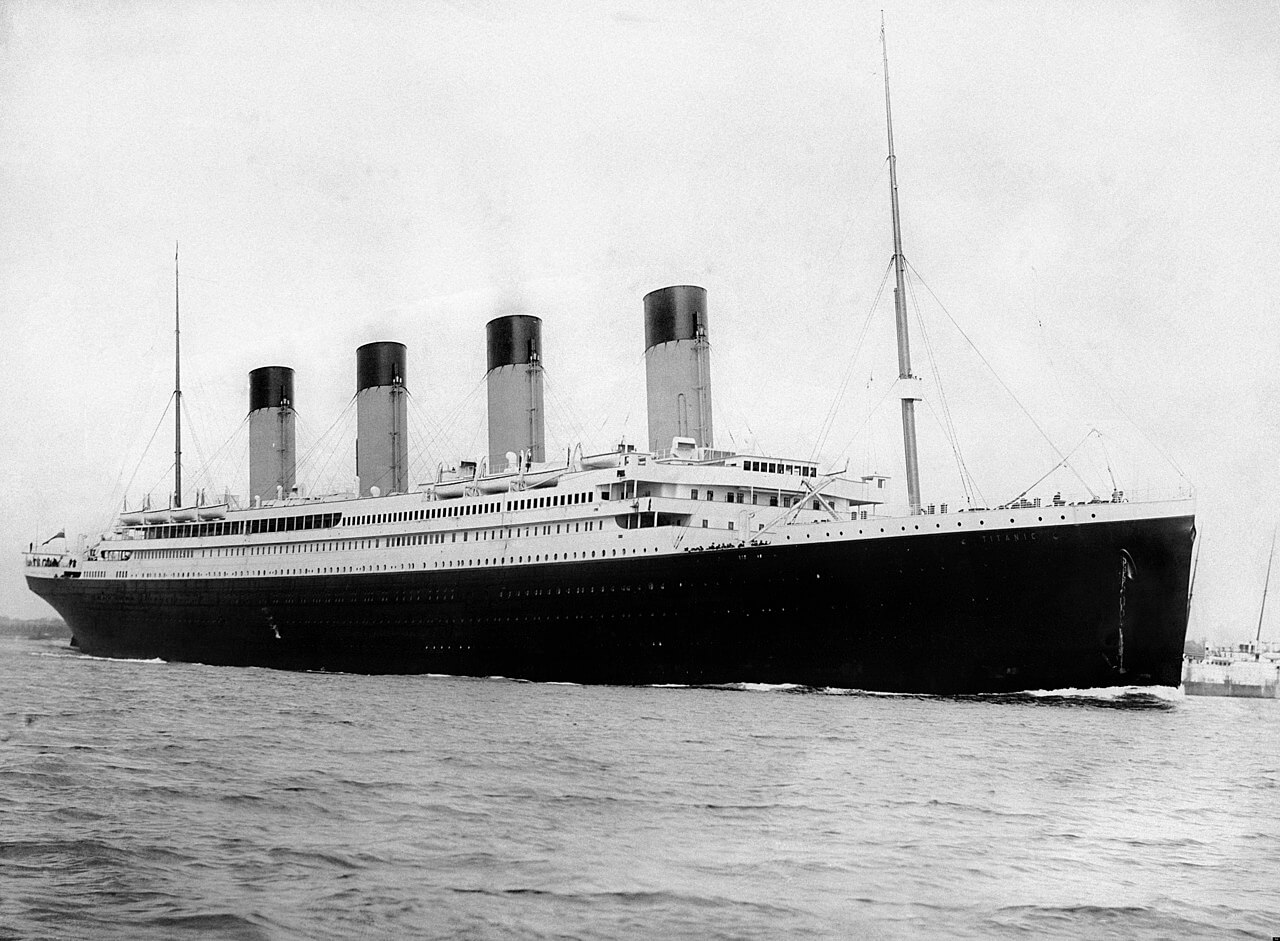
Considered ‘unsinkable’, the Titanic sank after hitting an iceberg which is believed to have originated in Ilulissat.
Perhaps the most famous ship in history, the legendary RMS Titanic was the largest ship in the world at the time of her launch and was built to be ‘unsinkable’.
A luxury passenger ship, her maiden voyage began on Wednesday, 10 April 1912 from Southampton, UK, with an estimated 2,224 passengers and crew who were bound for New York City.
At 11:40 pm on the 14th of April, a lookout crew member spotted an iceberg immediately ahead of Titanic and alerted the bridge. The first officer ordered the ship to be steered around the obstacle, but it was too late; the starboard side of Titanic struck the iceberg, creating a series of holes below the waterline.
By 2:30 am, the ship had sunk, resulting in the loss of 1,500 lives, mostly men. About 710 people survived the disaster and were conveyed by the ship Carpathia to New York City.
It is widely believed that the iceberg which sunk the Titanic had originated in Ilulissat.

A commemorative plaque in Narsarsuaq honours the Japanese adventurer, Naomi Uemura, who travelled the length of the Greenland Ice Sheet solo.
While the vast Greenland Ice Sheet may seem to be a daunting environment for most, it provided the perfect challenge for Japanese adventurer Naomi Uemura.
Fresh from his solo trek to the North Pole in 1978, making him the first person to reach the pole solo, Uemura turned his attention to the Greenland Ice Sheet.

Flying over the Greenland Ice Sheet, with a view of two glaciers which drain the ice sheet at the coastal periphery.
He assembled a dogsled team and travelled the length of the ice sheet, covering 2,600 km from the top to the bottom. He finished his journey in the southern settlement of Narsarsuaq where a plaque commemorates his amazing feat.

The midnight sun, reflecting off of icebergs in the Ilulissat Icefjord.
Greenland Vs Iceland

This is Greenland…

.. and this is Iceland!
It is true that Greenland is covered mostly in ice and snow while Iceland is verdant and green in many places. Why the name-switch?
The Vikings had a custom of naming places as they first encountered them.
When Erik the Red first landed in the southwest of Greenland in A.D. 982, it was probably a beautiful summer’s day and the view he encountered was most probably of green fields.
It is also mentioned in Nordic legend that Eric named the country Greenland in order to attract other settlers! Sneaky!
Likewise, Nordic legends say Naddador was the first Norse explorer to reach Iceland, and he named the country Snæland or “snow land” because it was snowing.
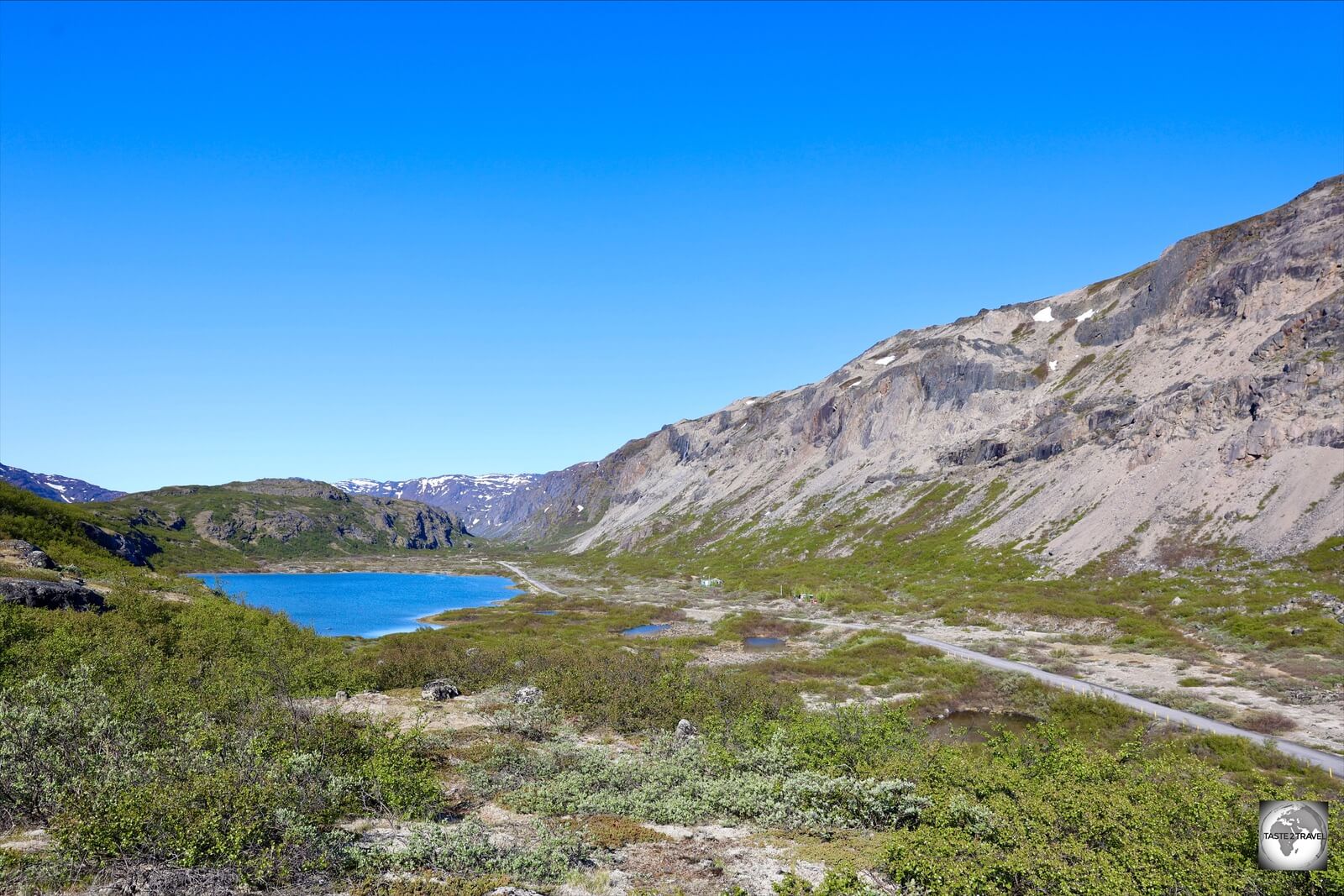
A view of Narsarsuaq in southern Greenland.
The summertime views around the southern settlement of Narsarsuaq (included in the ‘Sightseeing‘ section below) are of a very ‘green’ Greenland. Such green views are unique in Greenland and are only found in the southwest corner of the island during summer.
People

An art exhibition, showcasing Greenlanders, at the Nuuk Local Museum.
Home to 56,000 souls, the population of Greenland is concentrated mainly on the southwest coast, while the rest of the island is sparsely populated.

Inuit-language street sign in Ilulissat.
There are just 13 towns in Greenland, with a population greater than 1,000 inhabitants, while most other towns are small settlements.
All towns in Greenland are separated by great distances and are only reachable by either sea or air. There are no roads on Greenland!

A Greenlandic couple of newlyweds, enjoying the views of their magnificent island from the deck of the Sarfaq Ittuk.
The capital, and largest city is Nuuk, which is home to 17,600 inhabitants. The 2nd largest town is Sisimiut (pop: 5,620), followed by Ilulissat (pop: 4,737) then Qaqortoq (pop: 3,038).

Kalaallit Nunaat (“Country of the Greenlanders”) souvenirs in Qaqortoq.
The Greenlandic people are primarily Inuit who, depending upon the region they are from, call themselves Kalaallit (West Greenlanders), Inugguit (from Thule district), or Iit (East Greenlanders). They call their homeland Kalaallit Nunaat (“Country of the Greenlanders”).

A map in the Greenland Museum showing the migration of native Inuit from Asia, across the Arctic region, to Greenland.
Greenland was first settled by migrating native Inuit tribes who migrated across the North American Arctic region, from Asia, more than 4,500 years ago.

An Inuit whale-bone carving at the Ilulissat Art Museum.
The first Norseman to reach Greenland was Erik the Red in A.D. 982! Norsemen settled the uninhabited southern part of Greenland beginning in the 10th century, having previously settled Iceland.

Detail of Inuit clothing at the Greenland National Museum in Nuuk.
These Norsemen later set sail from Greenland and Iceland, with Leif Erikson becoming the first known European to reach North America nearly 500 years before Columbus reached the Caribbean islands.
Since at least the 17th century, Denmark has affirmed sovereignty over Greenland. In 1979, Denmark granted home rule to Greenland and; in 2008, Greenlanders voted in favour of the Self-Government Act, which transferred more power from the Danish government to the local Greenlandic government.
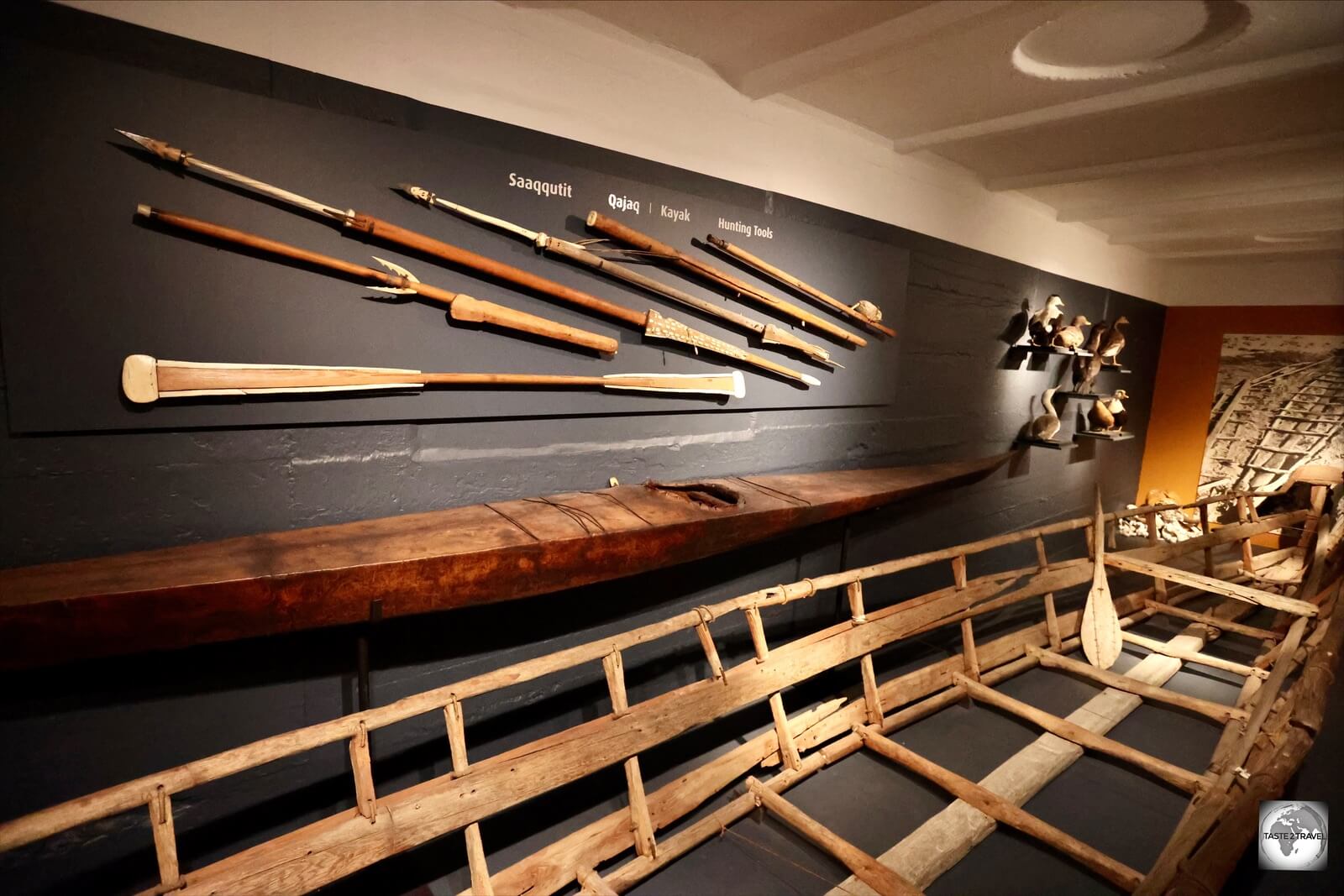
The Inuit gave the world the ‘Kayak, seen here at the Greenland National Museum in Nuuk.
While the Danish government still retains control of citizenship, monetary policy and foreign affairs, including defence, the local Greenland government takes responsibility for all other domestic affairs.

Filipino staff at the ‘Arctic Sari Sari’ store, a Filipino mini-market, in Nuuk.
Of the population today, 90% are Inuit, while the remaining 10% is made up of Danes, Filipinos and Thais! There are currently 200 Filipinos working on Greenland, mostly in the service industry.
Inuit Handicrafts

The Ajagaq workshop in Nuuk is a great place to view traditional Inuit artisans at work and also offers the best value souvenirs on all of Greenland.
The Inuit have a strong cultural identity and artistic tradition, dating back thousands of years. The Kalaallit are known for an art form of figures called tupilak or a “spirit object”.

A bone-carver at the Ajagaq workshop was working on these carvings at the time of my visit.
Traditional art-making practices thrive in workshops throughout the country, including at the excellent Ajagaq workshop, which is located in an industrial estate in Nuuk. If you are looking to purchase your own “spirit object”, this is the place to do it – direct from the artisan!

The friendly Inuit gem-stone carver at the Ajagaq workshop in Nuuk.
Housed in a 2-story tin shed, the workshop is home to bone carvers, gem-stone carvers, woodworkers and soap-stone carvers. The artisans allow you to watch them at work and each of the rooms features a display case where finished products are displayed for sale.

An amazing work-in-progress, a dazzling cluster of Greenland rubies, at the Ajagaq workshop in Nuuk.
Prices at the Ajagaq workshop are a bargain compared to what you’ll pay at a fancy downtown boutique.
Flag

The flag of Greenland, as seen on the deck of the Sarfaq Ittuk.
The flag of Greenland was designed by Thue Christiansen and adopted on 21 June 1985. It is called Erfalasorput, which means “our flag”.
The red colour is called Aappalaartoq (“red”) and is used both in the Greenland flag and the Danish flag (Dannebrog). The red and white symbolise hundreds of years as part of the Kingdom of Denmark.
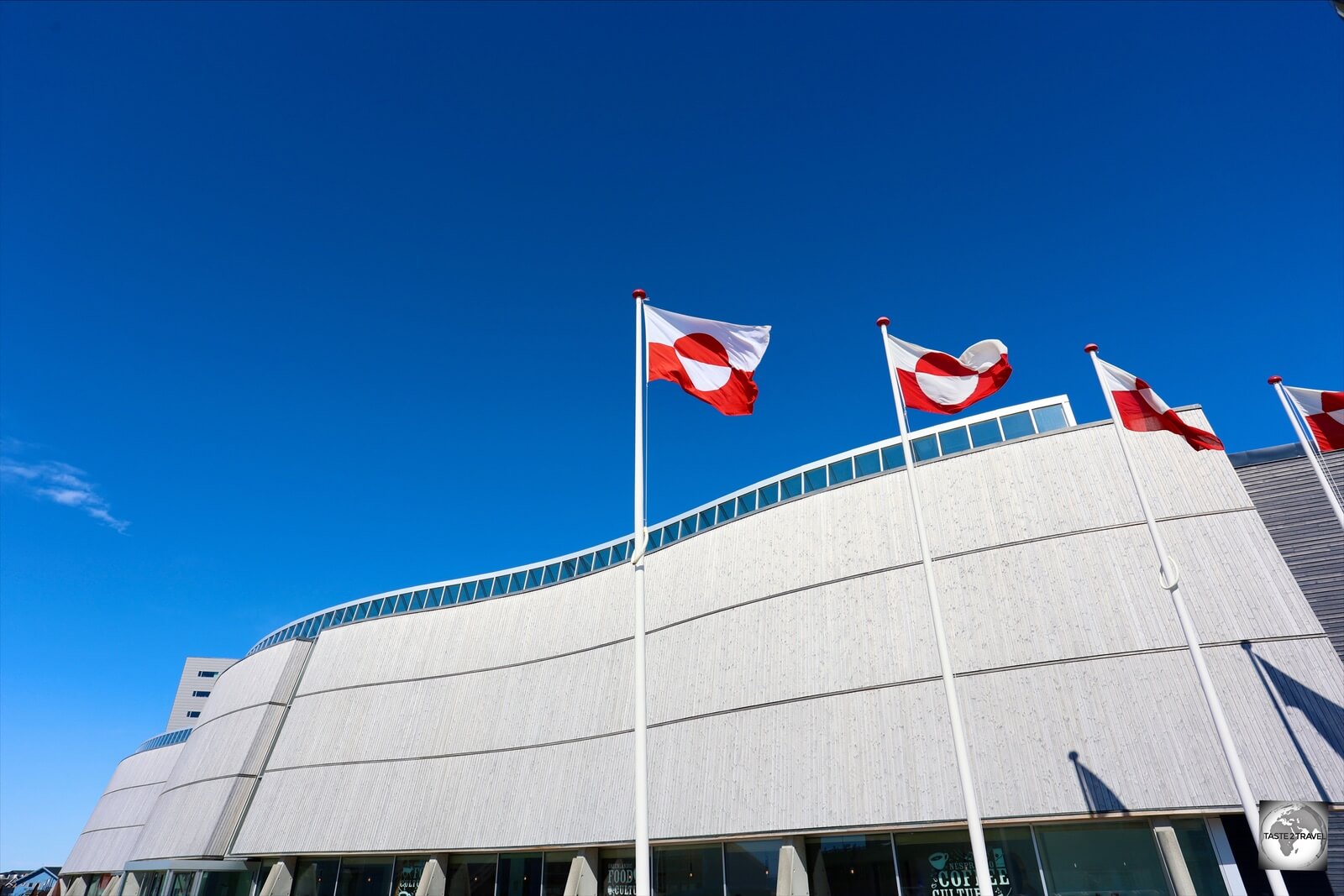
The flag of Greenland, flying outside the Katuaq Cultural Centre in Nuuk.
The design features two equal horizontal bands of white and red with a large disk slightly to the hoist side of centre.
The white stripe represents the many glaciers and the huge ice cap, which covers more than 80% of the island; while the red stripe, represents the ocean and the disk represents the sun.

The flags of Greenland and Denmark flying in Nuuk.
Currency

The Danish krone is the official currency of Greenland.
The official currency of Greenland is the Danish krone, which has the international currency code of DKK.
Banknotes are issued in denominations of 50, 100, 200, 500, 1000 kroner.
Little cash is used on Greenland, with most businesses preferring payment with credit card.

Banking services on Greenland are provided by the Bank of Greenland.
Costs
Very Expensive!
Like neighbouring Svalbard, travel costs in Greenland are on the extortionate side. This is no destination for budget travellers!
Flights to and from, and within, Greenland are operated by Air Greenland who take full advantage of their monopoly operation. A return airfare from Copenhagen to Ilulissat in July currently costs DKK10,000 (€1,340) while a short, one-way, domestic flight from Narsarsuaq to Nuuk (1:15 hrs) costs DKK3,000 (€400).
Suggested daily budgets:
- Budget: Not possible!
- Mid-range: DKK2,300 – 3,000 (€300 – 400)
- Top-end: DKK3,000+ (€400+)
An example of typical daily costs:
-
- Hotel Icefjord Apartments in Ilulissat (per night): DKK1,560 (€210)
- 2.5-hour cruise to the Ilulissat Icefjord with Disko Line Explorer: DKK695 (€93)
- Greenland Burger + drink for lunch at Café Iluliaq in Ilulissat: DKK112 (€15)
- Steak (225g) dinner + beer (.45L) at the Best Western Hotel Ilulissat rooftop restaurant: DKK313 (€42)
- Total for one day = €360

The drinks menu at a cafe in Ilulissat.
Sample costs:
- Coca Cola (0.33L bottle): DKK16 (€2.15)
- Water (0.33L bottle): DKK14 (€2)
- Beer (.3L glass): DKK65 (€8.73)
- Cappuccino: DKK40 (€5.37)
- Meal (budget restaurant): DKK120 (€16)
- Meal (expensive restaurant): DKK500 (€67)
- Mid-range Accommodation – Hotel Icefjord Apartments in Ilulissat (per night): DKK1,560 (€210)
- Top-end Accommodation – Explorer Room at Hotel Icefjord in Ilulissat (per night): DKK3,995 (€536)
- Taxi from Nuuk airport to downtown Nuuk: DKK120 (€16)
- ‘Couchette Class’ boat ticket on the MV Sarfaq Ittuk passenger ship from Ilulissat to Qaqortoq (including all meals): DKK4,438 (€596)
- Roundtrip International airfare from Copenhagen to Ilulissat with Air Greenland: DKK10,000 (€1,340)
- One-way domestic airfare from Narsarsuaq to Nuuk (1:15 hrs) with Air Greenland: DKK3,000 (€400)
Philately
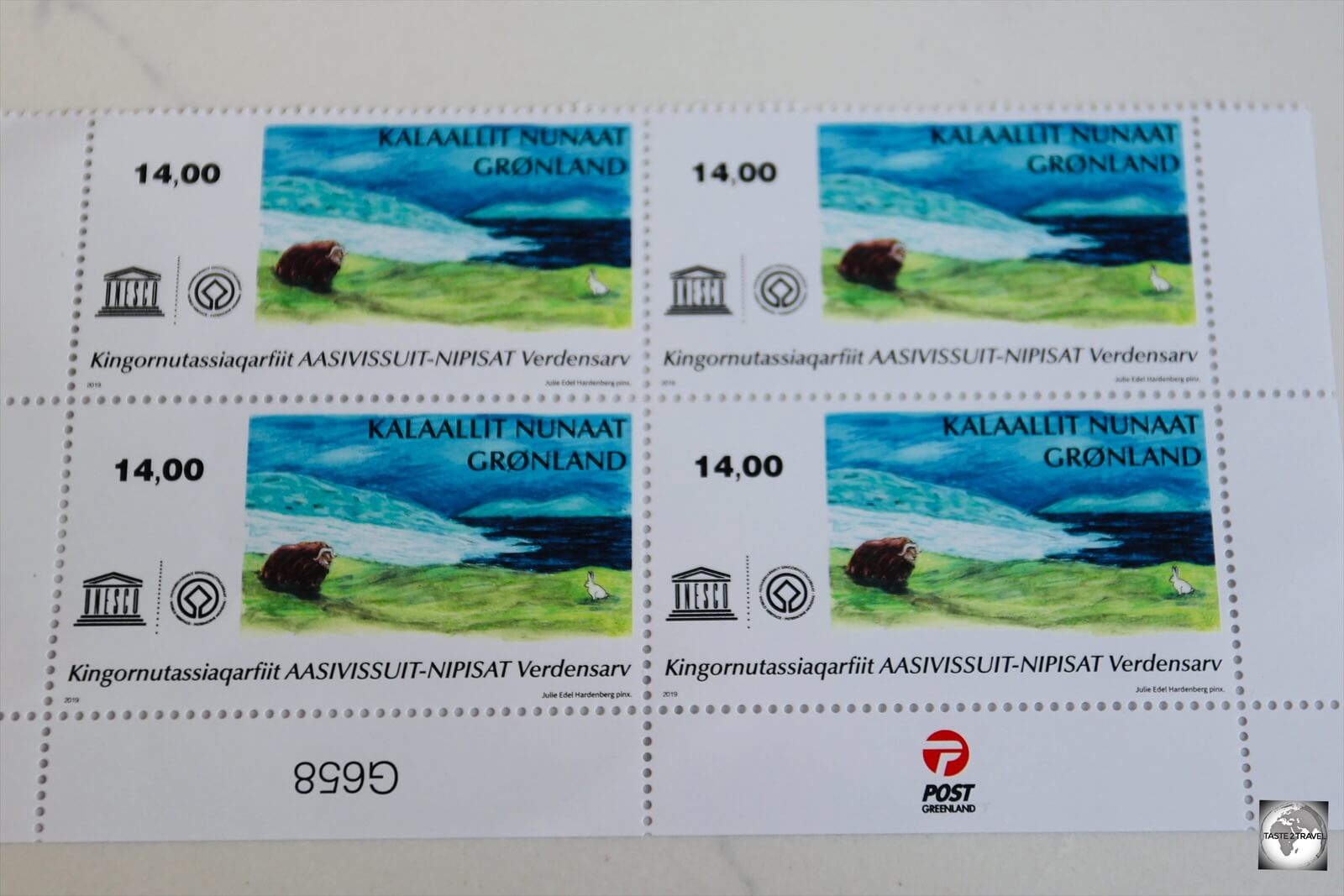
Greenland stamps are issued by Greenland Post.
The stamps of remote Greenland are popular among collectors around the world.
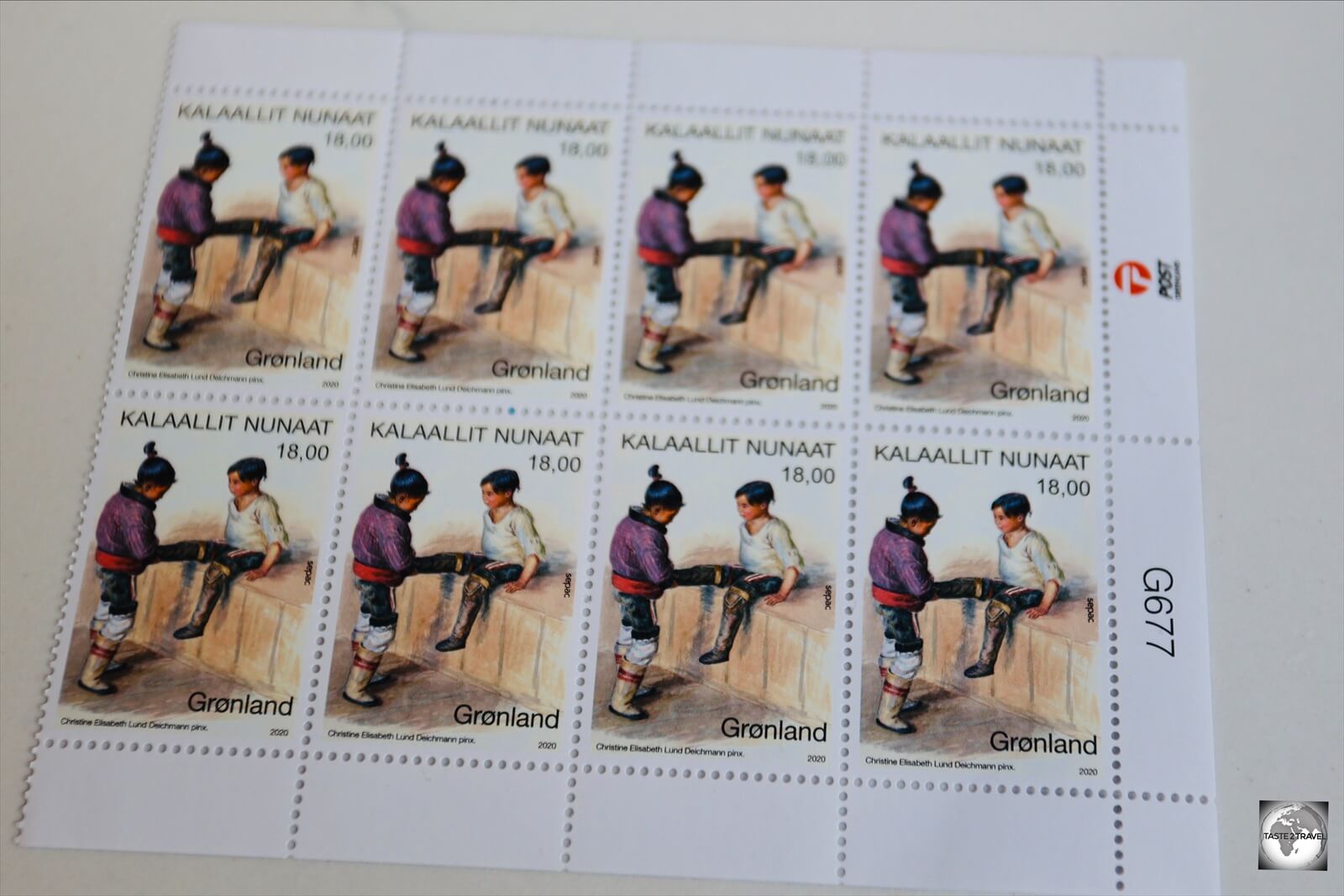
The stamps of Greenland depict local cultural themes.
Greenland Post, branded locally as Tusass, issues stamps each year which feature the culture, nature and history of Greenland. They currently provide philatelic services to collectors in more than 50 counties across the world.

Postal services are provided by Greenland Post – known locally as ‘Tusass’.
While in Greenland, you can purchase stamps at the local Tusass post office, or at major hotels.

The stamps of Greenland feature Arctic wildlife such as walruses.
From outside of Greenland, you can purchase stamps online from the Tusass website.
Midnight Sun

A collage of the midnight sun, taken by me from the deck of the Sarfaq Ittuk, with exposures every 20-minutes.
The midnight sun is a natural phenomenon that occurs in the summer months in places north of the Arctic Circle or south of the Antarctic Circle, when the Sun remains visible at the local midnight.

The midnight sun over Disko Bay, Ilulissat.
The midnight sun is visible in latitudes from 65°44′ to 90° north or south, and does not stop exactly at the Arctic Circle or the Antarctic Circle, due to refraction.
In Greenland, the Midnight sun can be observed in areas to the north of Sisimiut, which includes Ilulissat. However, due to refraction, Nuuk (latitude: 64.1743° N), experiences 24 hours of daylight during the summer months.
The opposite phenomenon, polar night, occurs in winter, when the Sun stays below the horizon throughout the day.
Sarfaq Ittuk
The most significant sightseeing opportunity in Greenland!

The Sarfaq Ittuk passenger ship arriving in Ilulissat.
The most vital public transport service in Greenland is provided by the Sarfaq Ittuk, a passenger ship operated by Arctic Umiaq Line, which plies the waters of southwest Greenland, providing a vital lifeline to eleven remote towns and settlements.

Cruising past icebergs on the Sarfaq Ittuk.
While the ship provides a crucial service for communities along the southwest coast, it also provides tourists with an affordable way of moving along the coast and experiencing the incredible scenery which Greenland offers in abundance.

The Sarfaq Ittuk offers incredible views of the Greenland coastline.
The Sarfaq Ittuk provides a Greenland sightseeing cruise – at a bargain price!

A journey on the Sarfaq Ittuk offers incredible views of the coast of Greenland.
If you would rather cruise along the spectacular coast while rubbing shoulders with ordinary Greenlanders, the Sarfaq Ittuk is for you.

A rare, and very candid photo of me, taken by fellow passenger, and Danish traveller extraordinaire, Carsten Riddersholm. I had no idea he had taken it until he emailed it to me!
Of the passengers onboard, 90% are locals commuting to other towns, while 10% are sightseeing tourists.

The deck of the Sarfaq Ittuk provides perfect wildlife viewing.
The ship provides a fascinating insight into life in remote Greenlandic communities.

In the distance, a huge glacier drains into the sea, a typical sight on the coast of Greenland.
At each stop, the ship is greeted by hordes of emotional locals who are waiting on the dock for returning family and friends or saying farewell to a loved one who might be relocating elsewhere.

A view of the coast of Greenland, near Kangaamiut.
The ship’s route takes it through many protected channels which offer the best sightseeing opportunities.

The breath-taking scenery inside one of the many channels which the Sarfaq Ittuk sailed through.
It’s in these channels where whales prefer to feed, and where the towering mountains seem to close in on you.
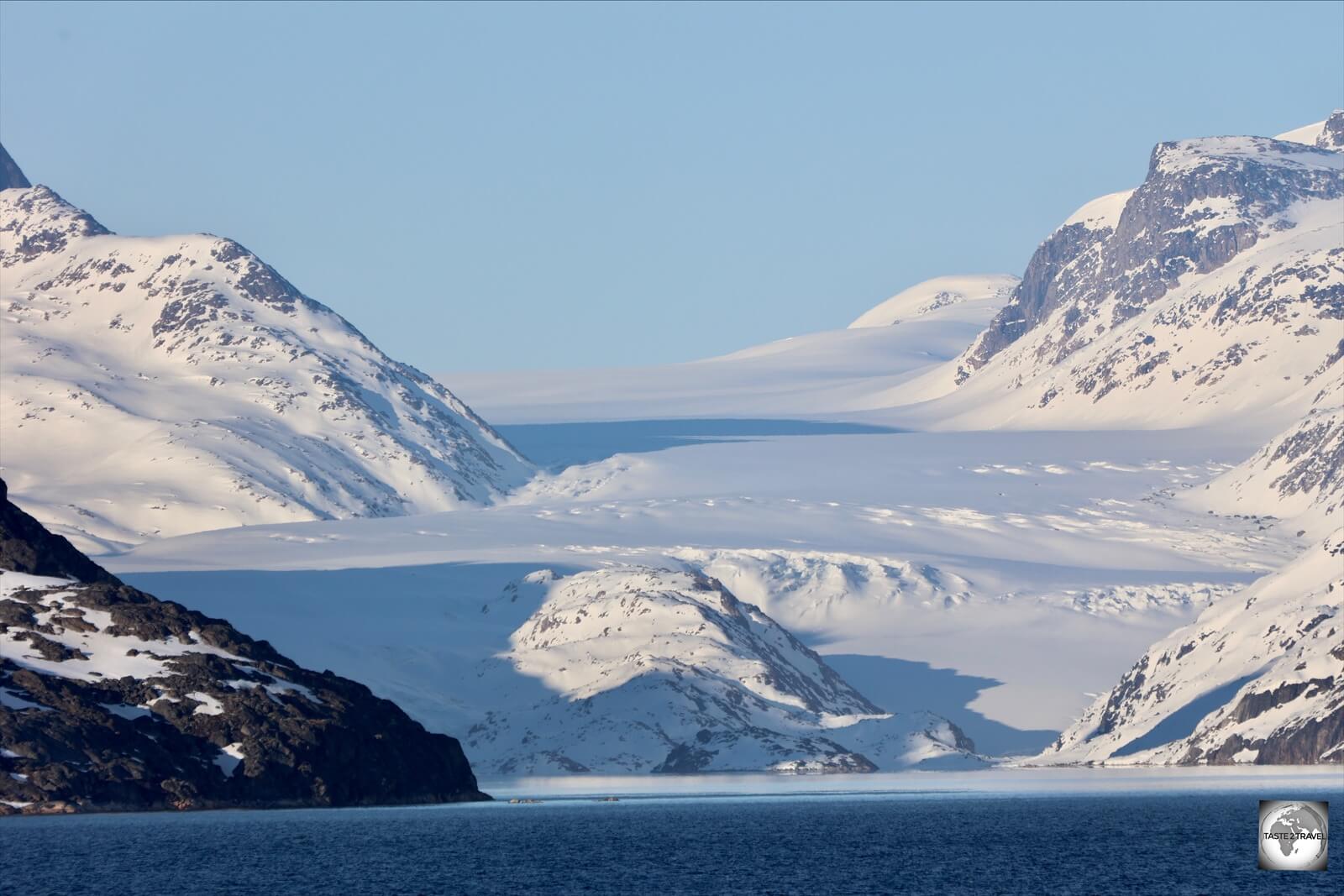
A view of one of the hundreds of glaciers which line the coast of Greenland.
In places, it seems the ship will not fit through the narrow passageways which are always surrounded of towering, granite cliffs.

For the captain of the Sarfaq Ittuk, the calmer waters of the many channels are preferred over the rougher open sea.
Route
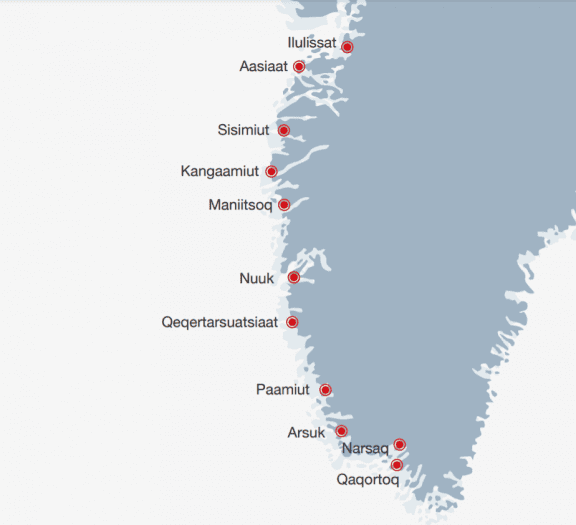
The Sarfaq Ittuk sails between Ilulissat and Qaqortoq.
The ship sails on a regular basis between the northern town of Ilulissat and the southern town of Qaqortoq, a distance of about 1,000 km, calling at a total of 11 ports.

The view from the deck of the Sarfaq Ittuk passenger ship.
Schedule
The sailing schedule can be viewed online at the company website. I joined the ship in Ilulissat and travelled the full length of the journey, arriving in the southern port town of Qaqortoq three days later.

Leaving Ilulissat on board the Sarfaq Ittuk.
Many passengers choose to travel from Nuuk either north or south, with a flight at either end. You can also stop off in other towns, depending on your preference.

A journey on the Sarfaq Ittuk will provide a lifetime of memories.
Rates
Rates are published online on the company website.
Tickets should be purchased online, in advance.
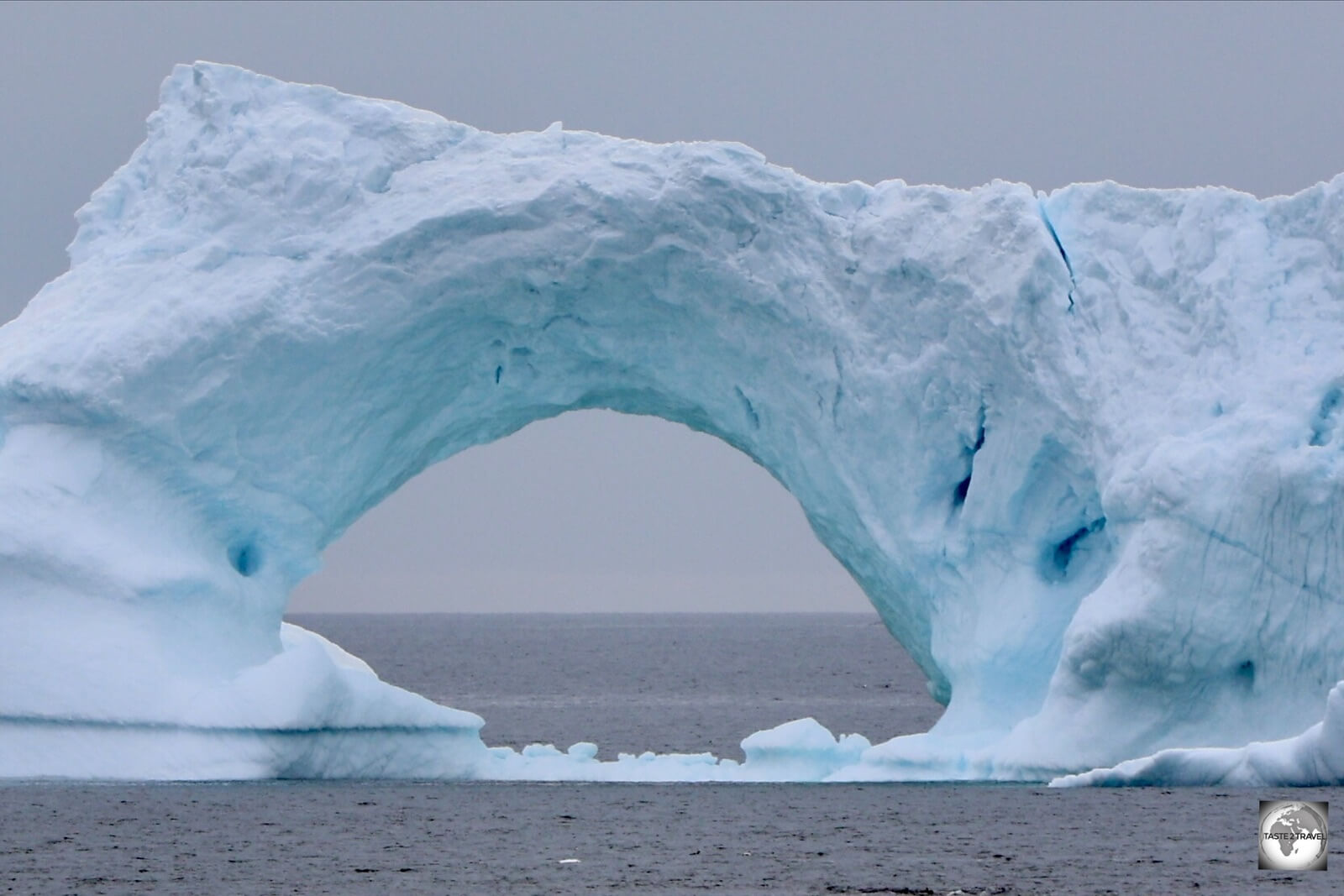
The Sarfaq Ittuk allows you to get up close to many towering icebergs.
The ship carries 270 passengers, with accommodation options including either private cabins or the more communal, and budget-friendly, ‘couchette’ class.

A view of the Greenland coast near Sisimiut.
As a single traveller, I paid DKK3,275 (€440) to travel in ‘couchette’ class, which meant using shared bathrooms, for the entire journey. As a comparison, the cost of a single cabin would have been DKK8,575 (€1,152).

Icebergs are a constant obstacle for the crew of the Sarfaq Ittuk.
If you are travelling in a group, there are 2,3 and 4-bed cabins available which work out to be much more affordable on a per person basis.

Travelling through one of many channels on the Sarfaq Ittuk.
Meals
Meals are served in the restaurant, three-times per day, and can either be purchased in advance or paid for separately.

The Sarfaq Ittuk entered through this wall of fog south of Nuuk and remained in the fog for much of the day.
Since there are no other meal options, I chose to prepay for all meals which cost me an additional DKK270 (€36) per day.

The scenery along the coast of Greenland reminded me of Antarctica.
The food which is served is bland, uninspired, cafeteria-style food! Meals were not a highlight of the trip.

Reindeer grazing close to Qaqortoq.
Sarfaq Ittuk Brochure Links
- Brochure 1: “Welcome on Board“
- Brochure 2: “Itinerary, Schedules and Route Map“
- Brochure 3: “Cafe Sarfaq“
Sightseeing

The Ilulissat Icefjord is the #1 tourist attraction in Greenland.
Note: The towns in the Sightseeing section are arranged in the order in which I visited them. The capital, Nuuk, was the last town I visited and as such is located at the bottom of this section.

What you are looking at is the sea – a view of the ice-filled Ilulissat Icefjord.
Ilulissat

Hiking trails in Ilulissat offer stunning views of the magnificent Ilulissat Icefjord.
If you could visit just one place in Greenland, it would have to be Ilulissat!

Large enough to land a small plane upon – this is a floating iceberg!
The number one tourist attraction in Greenland is the incredible Ilulissat Icefjord, one of three UNESCO World Heritage sites in Greenland.

A diagram showing a cross-section view of the Ilulissat Icefjord.
Source: https://journals.ametsoc.org/view/journals/phoc/45/1/jpo-d-14-0044.1.xml
The Ilulissat Icefjord serves as the outlet of the Jackobshavn glacier, which drains the Greenland Ice Sheet. This is one of the few places where the ice sheet reaches the sea.

I spent one week in Ilulissat and never tired of the views of the spectacular Icefjord.
The glacier is one of the most active in the world, calving around 35 km3 of ice per year.

Icebergs on top of icebergs! The larger icebergs block the mouth of the Icefjord, resulting in an iceberg traffic jam!
The icebergs, which calve from the Jackobshavn glacier, slowly float down the 50 km long, 550 metre deep, Ilulissat Icefjord.

This is the definition of breath-taking! Hard to believe this is real!
Eventually they reach the sea, and mouth of the Icefjord which is a much shallower 250 metres.

Canada Geese at Ilulissat.
Many of the larger icebergs become stuck at this shallow point, remaining in place for many years, until they break up into smaller icebergs.
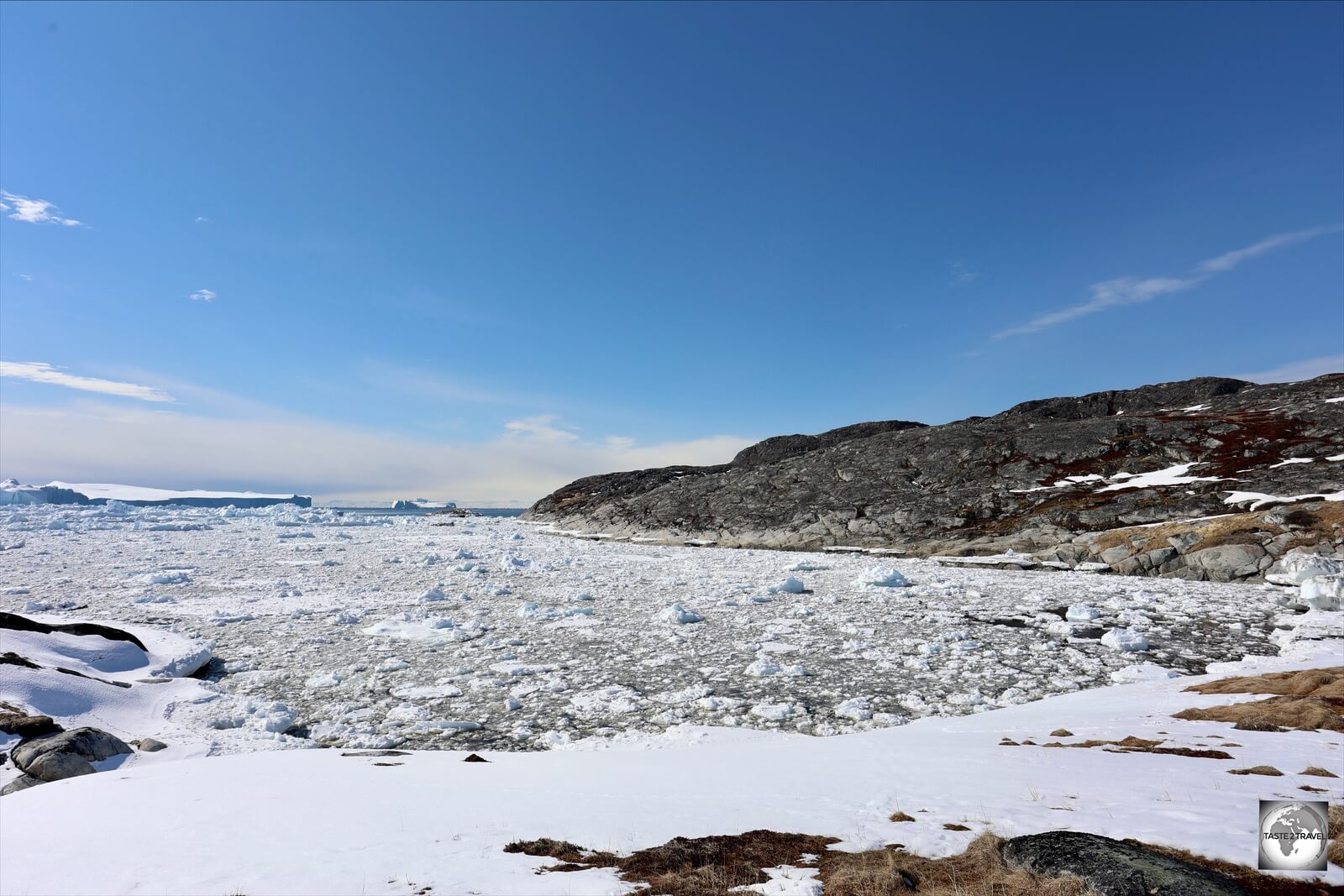
A view of the Ilulissat Icefjord from a hiking trail. Warning signs in this bay warn against tsunami waves caused by calving icebergs.
For visitors, there are numerous options for getting up close to these majestic ice mountains. There are a number of hiking trails, which set out from the Ilulissat Icefjord Visitor’s Centre.

The Ilulissat Icefjord Visitor’s Centre provides information on the Ilulissat Icefjord and is the starting point for various hiking trails.
Warning signs along the coast warn of the possibility of tsunami waves which can result from the calving of huge blocks of ice from the glacier, which is located 50 km inland.

The wooden roof of the Ilulissat Icefjord Visitor’s Centre offers its own walking trail.
Icefjord Boat Cruise

Getting up close to the Ilulissat icebergs on a Disko Line Icefjord cruise.
You can also choose to do one of the nightly Icefjord boat cruises which depart from Ilulissat port.

Getting up close to the icebergs on a Disko Line Icefjord cruise.
I travelled with Disko Line – the same folks who run speedboat taxi services along the west coast of Greenland.

Crystal-clear glacier ice from the waters of Disko Bay.
During the cruise, our crew fished out of the water, a chunk of pure, crystal-clear, glacier ice.

A gin cocktail with a chunk of glacier ice is a highlight of a Disko Line Icefjord cruise.
This was broken up into smaller chunks, placed inside a crystal glass into which a gin cocktail was added. The cocktail featured a locally-produced syrup and Greenland Post (a local version of the herb – rosemary).
I asked “When does the bar close?” to which one witty passenger replied “When the ice runs out“. Ha-ha!

The guide on our Disko Line Icefjord cruise, providing information on the Icefjord.
Highly Recommended!

It’s hard to believe that these are floating mountains of ice!
While the Icefjord dominates everything in Ilulissat, the town holds a few other attractions.

A boardwalk hiking trail which leads to the Icefjord from the visitor’s centre.
Zion’s Church

The picturesque Zion’s church, overlooks Disko Bay in Ilulissat.
Occupying an incredible setting, overlooking the iceberg-filled Disko Bay, the very photogenic Zion’s church is the oldest church in Greenland.

The flag of Greenland flying alongside Zion’s church in Ilulissat.
When it was completed in 1779, this Lutheran church was the largest building in Greenland.
Ilulissat Art Museum

The Ilulissat Art Museum holds an interesting collection of Arctic-themed art.
Opened in 1995, the Ilulissat Art Museum is housed in the former residence of the colony manager, which was constructed in 1923.

One of the galleries inside the Ilulissat Art Museum.
The focus of the museum is Arctic-themed art, with the permanent collection comprised of a series of paintings by Emanuel A. Petersen, a Danish impressionist and modern painter who specialised in the Arctic.
Knud Rasmussen Museum

The Knud Rasmussen Museum contains displays which tell of the life of Knud Rasmussen, local explorer and anthropologist.
Otherwise known as the Ilulissat Museum, the Knud Rasmussen Museum is dedicated to the man himself. Knud Johan Victor Rasmussen was a Greenlandic–Danish polar explorer and anthropologist.

The stairway of the Knud Rasmussen Museum is lined with seal skins.
The son of a Danish missionary and a Danish-Inuit mother, Rasmussen was born in Ilulissat, where he spent his early years immersing himself in the Inuit culture.
Apart from learning the Inuit language, he learnt to hunt, drive dog sleds and live in harsh Arctic conditions.

Displays inside the Knud Rasmussen Museum in Ilulissat.
A true Arctic specialist, he was the first European to cross the Northwest Passage via dog sled. Wow!
Aasiaat
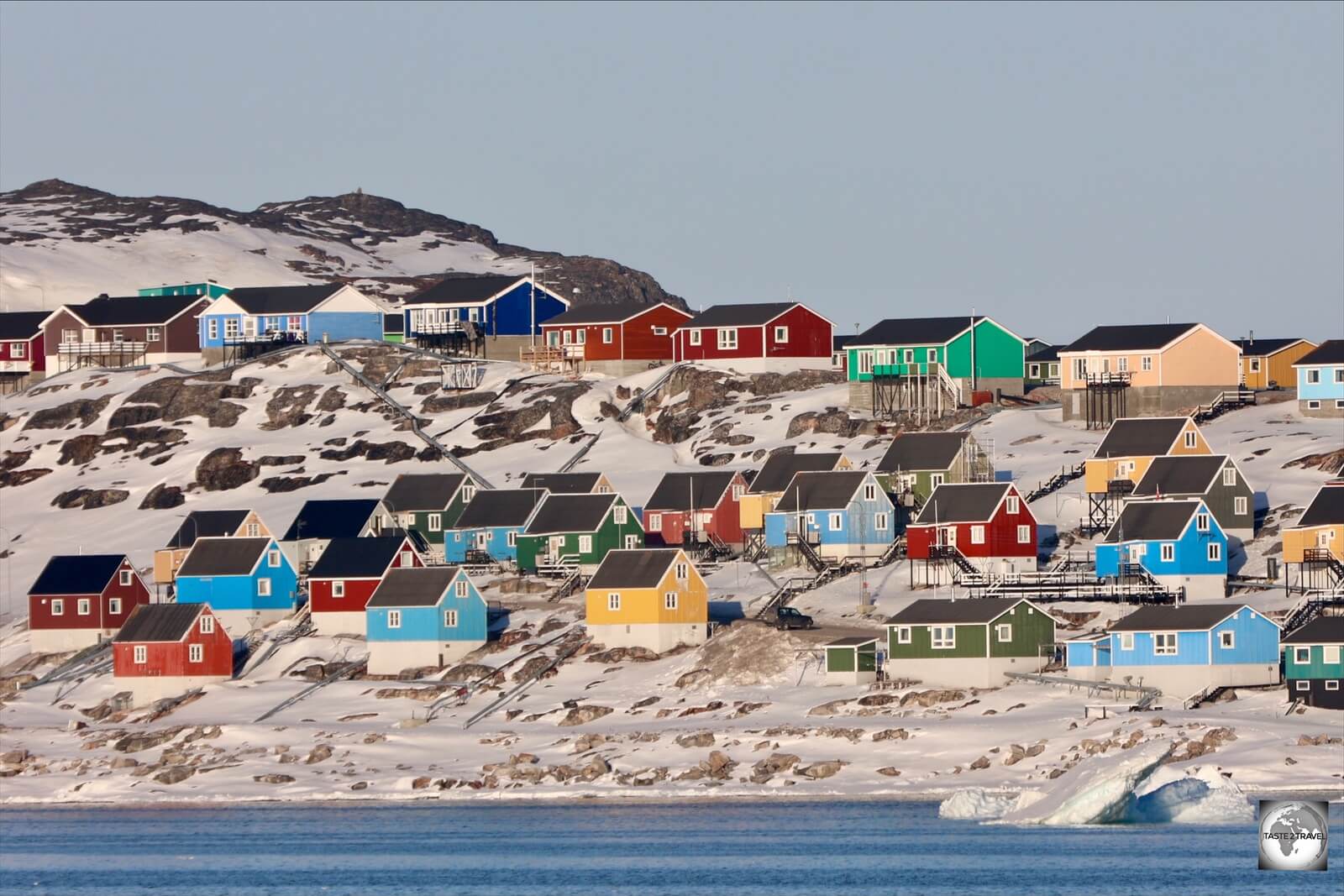
A view of Aasiaat from the Sarfaq Ittuk.
Located at the southern end of Disko Bay, Aasiaat is the 2nd stop of the Sarfaq Ittuk on its meander south. Home to 3,069 inhabitants, Aasiaat is Greenland’s 4th largest town.

The midnight sun, as seen from the deck of the Sarfaq Ittuk, near Aasiaat,
Sisimiut

A view of Sisimiut, the 2nd largest town in Greenland.
Sisimiut has been a settlement site for around 4,500 years. It is considered to be the cradle of civilisation for the Greenlandic people.

A view of Sisimiut, Greenland.
Today, Sisimiut is home to 5,582 inhabitants, making it the 2nd largest town in Greenland.
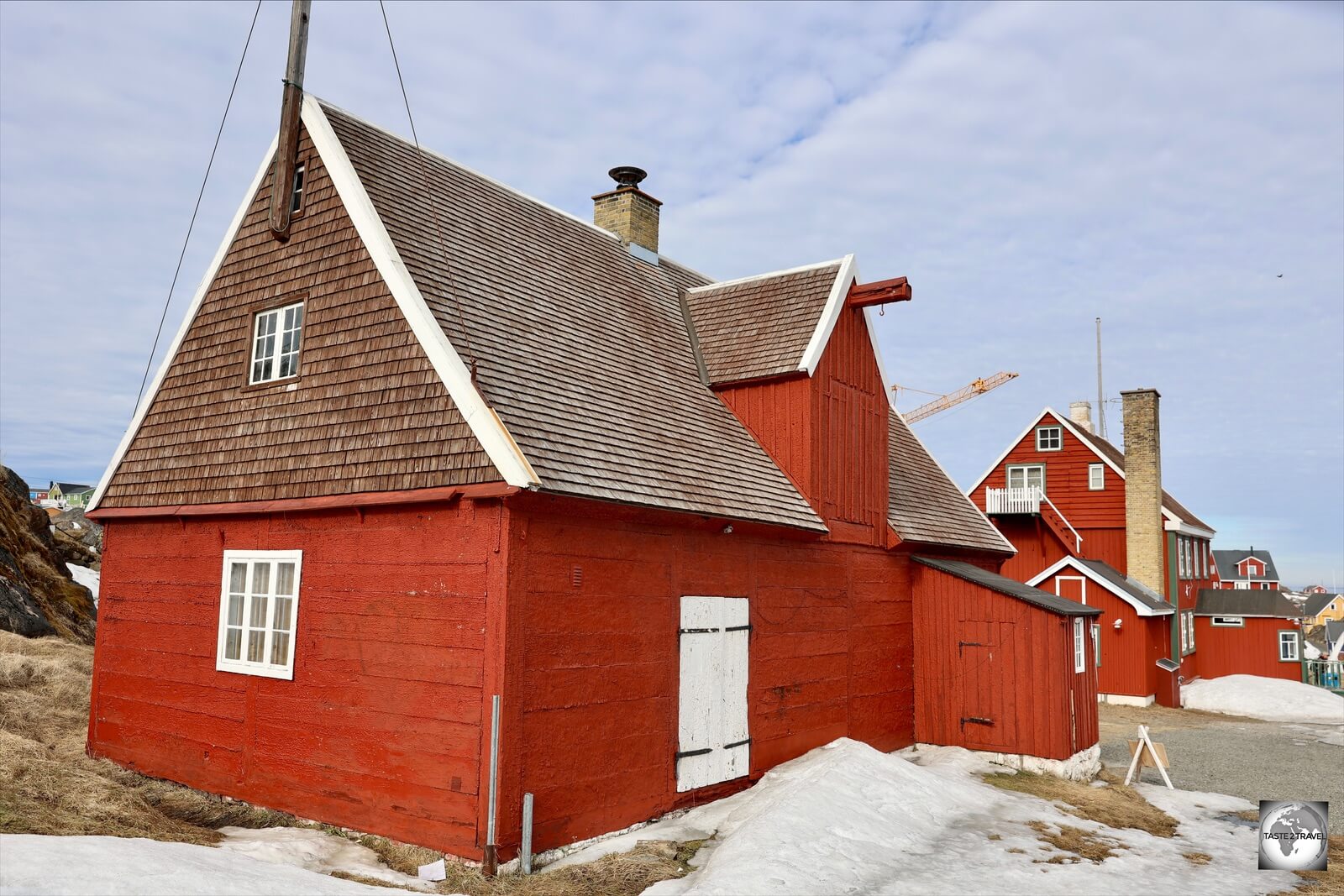
The Sisimiut Museum showcases 4,500 years of settlement in the region.
The Inuit of the Thule culture, whose descendants form the majority of the current population, arrived nearly a thousand years ago, with the first arrivals dated to approximately 13th and 14th century.

Sleds, parked on the side of the road in Sisimiut.
The first wave of settlers was the Saqqaq culture, who arrived 4,500 years ago from Arctic Canada during the first wave of immigration, occupying numerous sites on the coast of western Greenland.
The inland region is home to one of 3 UNESCO World Heritage sites in Greenland, “Aasivissuit – Nipisat. Inuit Hunting Ground between Ice and Sea“.

The beautiful, blue Bethelkirken is a highlight of the Sisimiut Museum complex.
If you are travelling on the Sarfaq Ittuk, you will have a 3-hour port call, which is ample time to explore the few sights in town, which are focussed around the excellent Sisimiut Museum complex.

Detail from the Bethelkirken, Sisimiut.
The museum is housed in a number of old colonial buildings, some of which have been transported to the site.
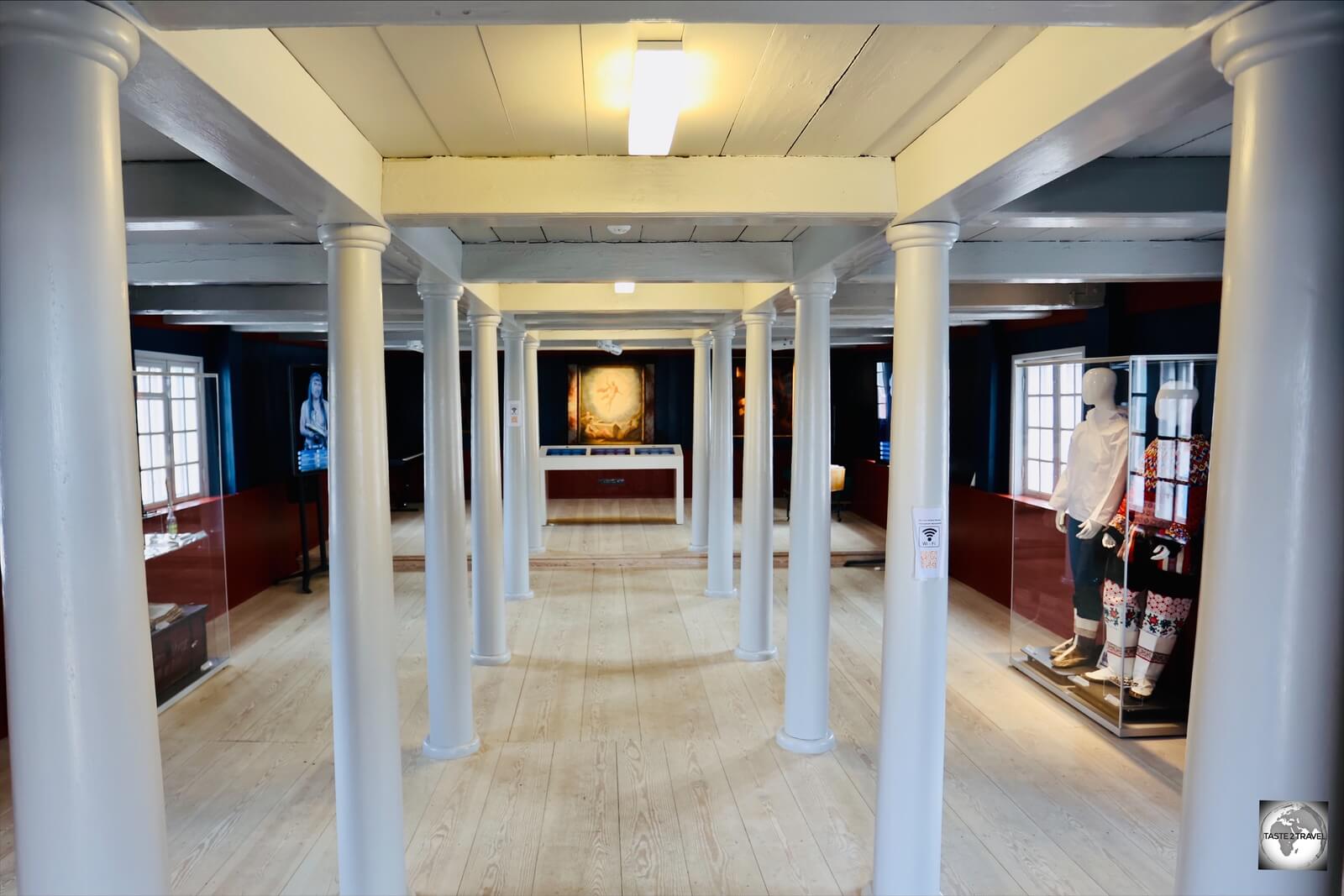
Interior view of the Bethelkirken, which was first pre-assembled in Copenhagen before being shipped to Sisimiut.
A highlight of the museum is the beautiful blue church, Bethelkirken, which is Greenland’s oldest church, dating from 1771.

Fridge magnet souvenirs of Sisimiut.
The church has a fascinating history, having first been pre-fabricated in Copenhagen in 1771, for which the people paid with 60 barrels of blubber from four whales.

Displays at the Sisimiut Museum.
It was at first erected and disassembled in Denmark, so that the parts could be numbered, in order to allow the people in Greenland to erect it themselves.

A turf house, and other buildings, which form the Sisimiut Museum complex.
Apart from the church, the museum is home to a turf house, various historic wooden boats, and an archaeological exhibition where you can see relics from the Saqqaq culture.
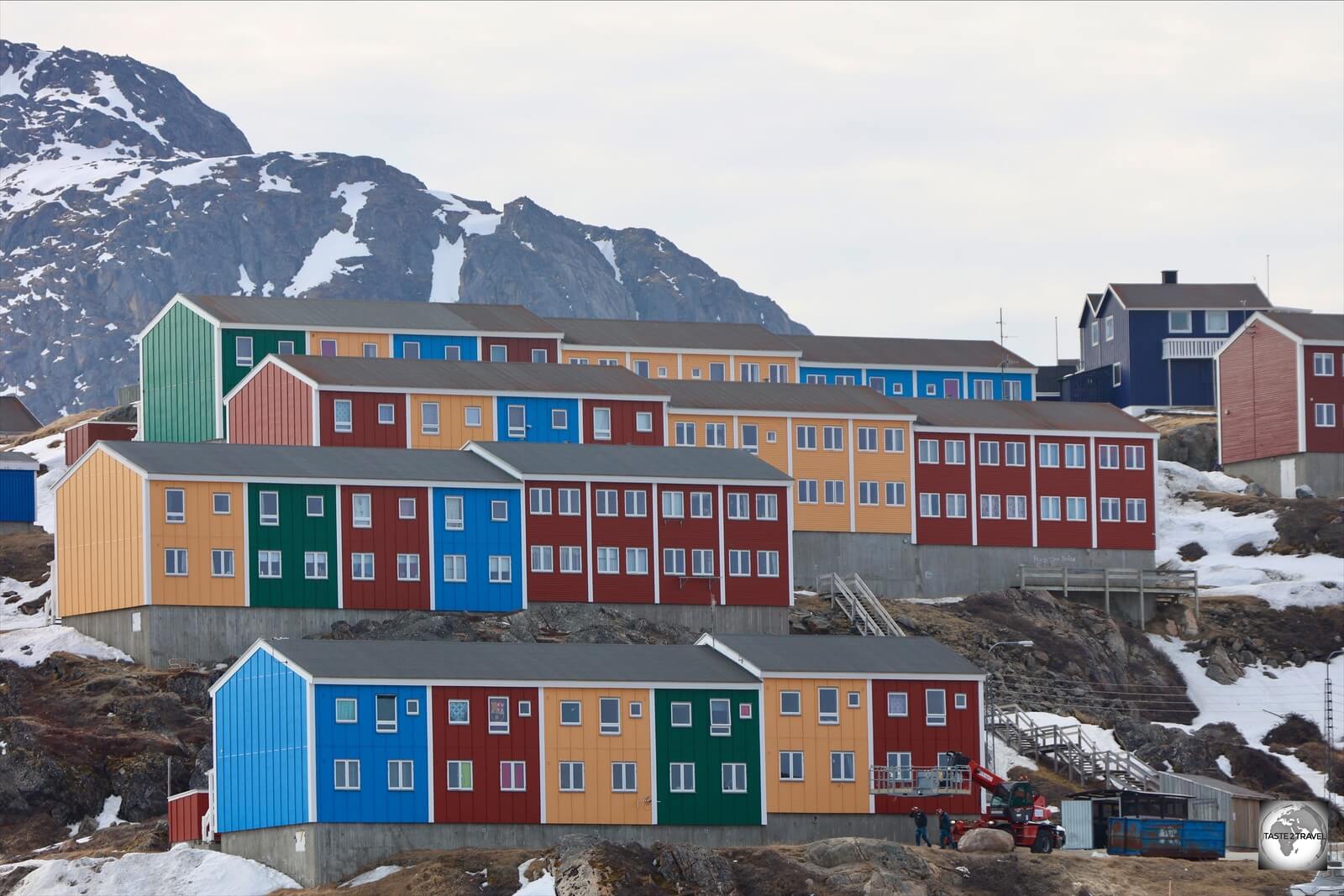
Modern houses in Sisimiut.
Getting There
Air
Air Greenland operate regular domestic flights from Sisimiut airport to both Nuuk and Kangerlussuaq Airport, which is located 129 km inland from Sisimiut.
Sea
The Sarfaq Ittuk calls at Sisimiut during its journey along the coast, spending 3-hours in port.
Kangaamiut

A stunning setting! The settlement of Kangaamiut is a port of call for the Sarfaq Ittuk.
Located south of Sisimiut, the tiny settlement of Kangaamiut (pop: 293) is tucked into a tight bay, which is surrounded on almost all sides by large granite mountains and submerged granite boulders.

The Sarfaq Ittuk deploys its tender in order to access the small settlement of Kangaamiut.
The narrow entrance to the harbour meant that, during its port call, the Sarfaq Ittuk had to moor in a nearby channel, while the boat’s tender was lowered into the water and used to transfer passengers to and from the boat. It was a fascinating operation!

Transferring passengers from the Sarfaq Ittuk to the small dock in Kangaamiut.
Although settled by the Danish in 1755, Kangaamiut has experienced a significant population decline in recent years, losing more than 36% of its population relative to 1990 and more than 26% relative to 2000.

The tiny settlement of Kangaamiut is one of eleven ports served by the Sarfaq Ittuk.
Getting There
Apart from the Sarfaq Ittuk, Kangaamiut can be reached via speedboat from Maniitsoq with the Maniitsoq Tour Boat company.

A local from Kangaamiut travelled out in his boat to greet the Sarfaq Ittuk.
Greenland Summer Houses
Can you spot the summer houses in these images?
Where do Greenlanders go for their summer holidays? Those that live in remote settlements such as Kangaamiut or Maniitsoq face difficulties when wanting to travel.

Can you spot the summer houses in these images?
Air connections are limited and expensive and the weekly Sarfaq Ittuk boat is hardly convenient! It’s an almost impossible feat to pack your bags and head to a beach in Spain or Portugal.
For some, the solution is a remote summer house!

As seen from the sea, this summer house is built in the shadow of the icing-smooth, Greenland Ice Sheet.
These lonely escapes can be seen standing in complete isolation along the shores of the remote fjords.

A Greenland summer house provides the perfect opportunity to drop off the grid!
Maniitsoq

Out first glimpse of Maniitsoq from the Sarfaq Ittuk.
Maniitsoq is home to 2,534 inhabitants, making it the sixth-largest town in Greenland.
Video:
Arriving in Maniitsoq on the Sarfaq Ittuk with a group of local school children returning home.
Archaeological finds indicate that the area has been settled for more than 4,000 years. The modern town dates to 1782, when Danish colonists established a settlement here.

At each port, such as Maniitsoq, crowds of family and friends gather to greet and farewell loved ones.
Maniitsoq, which is located 148 km north of Nuuk, is a popular winter sport destination, offering heli-skiing in the interior regions.
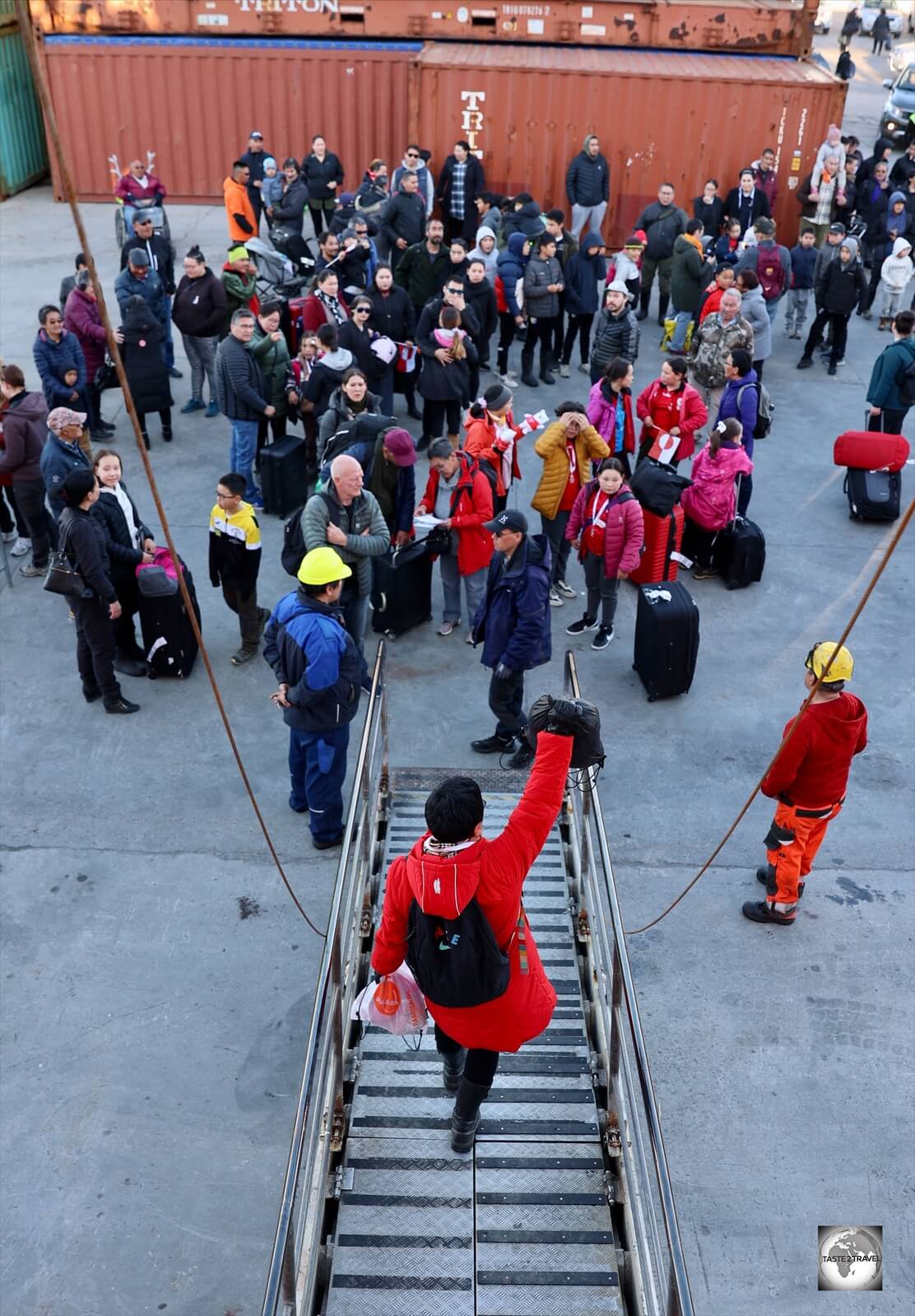
The Sarfaq Ittuk provides a lifeline to remote coastal settlements such as Maniitsoq.
As with nearby Kangaamiut, Maniitsoq has experienced a decline in population, losing almost 15% of its population relative to 1990 levels, and nearly 9% relative to 2000 levels.

The midnight sun near Maniitsoq.
Getting There
Air
Air Greenland operate regular domestic flights from Maniitsoq airport to both Nuuk and Kangerlussuaq Airport.
Sea
The Sarfaq Ittuk makes a brief port call during its journey along the coast.
Paamiut

On its southbound journey, the Sarfaq Ittuk arrives in Paamiut, just before midnight.
With a population of 1,308 inhabitants, Paamiut is the tenth-largest town in Greenland. It is one of the 11 stops made by the Sarfaq Ittuk on its epic meander along the southwest coast of Greenland.
Qaqortoq

A view of Qaqortoq, the largest town in southern Greenland, with the Qaqortoq Museum (black building) in the foreground.
Beautiful and charming Qaqortoq (pop: 3,050) is the largest town in southern Greenland. It was near here that Eric the Red first arrived and named the country Greenland.

A summertime view of Lake Tasersuaq.
Qaqortoq is home to one of three UNESCO World Heritage sites in Greenland. The ‘Kujataa‘ site, which is located on the shores of Lake Tasersuaq, represents the earliest introduction of farming to the Arctic and the Norse expansion of settlement beyond Europe.

Qaqortoq is located between the sea and the picturesque Lake Tasersuaq.
The small, compact, colonial-era, town centre lies between the port and the picturesque Lake Tasersuaq.

The charming Church of Our Saviour in Qaqortoq, which dates from 1832.
Sights in town include the beautiful Church of Our Saviour which was built in 1832.

The memorial, and lifebuoy ring, from the MS Hans Hedtoft, inside the Church of Our Saviour in Qaqortoq.
The church houses the commemorative wreath and the lifebuoy for the MS Hans Hedtoft, which sank south of Cape Farewell, on her maiden voyage on January 30, 1959.

The interior of the Church of Our Saviour in Qaqortoq.
The lifebuoy was found on Iceland and is the only wreckage found of the ship.

The Qaqortoq museum is housed in a former blacksmith’s workshop.
A short walk from the church, the Qaqortoq museum is housed in a former blacksmith’s workshop. The museum, which has erratic opening hours, features displays on the history of southern Greenland.

One of many beautiful stone carvings which can be seen around Qaqortoq.
Despite its small size, Qaqortoq is home to a large, creative artistic community.
As you walk around town, you can’t help but notice the numerous stone carvings, which have been carved out of the many large granite boulders which lie around town.
Step inside the Hotel Qaqortoq to view the many ‘polar bear’ paintings which line the walls of the hotel – the work of another local artist.

A giant Inuit boot graces the entrance to the Hotel Qaqortoq.
Then there is the giant Inuit boot which has been installed in front of the Hotel Qaqortoq!
Getting There

Views of the Tunulliarfik Fjord from my Disko Line speedboat, travelling from Qaqortoq to Narsarsuaq.
Air
Although it is the largest town in the south, Qaqortoq is currently served by a helipad, with helicopter transfers to Narsarsuaq airport, which connect with a once-daily domestic flight to Nuuk.
Air Greenland operate 20-minute helicopter flights from Qaqortoq to Narsarsuaq airport, with a one-way ticket costing around DKK1,100 (€148).
All of this will change once the new Qaqortoq International airport is completed in 2025.
Sea

The Sarfaq Ittuk, docked at Qaqortoq.
Qaqortoq is the southernmost port of call for the Sarfaq Ittuk, which arrives in town at 4 pm each Wednesday and then commences its northbound journey 3-hours later at 7 pm.
If you are travelling on the Sarfaq Ittuk, and not disembarking in Qaqortoq, the 3-hour port of call is enough time to explore the town.

The Disko Line dock in Qaqortoq.
Qaqortoq is the main southern hub for Disko Line speedboats, which depart from the port, and offer speedy connections to all towns in the south.

A view of Qaqortoq from my Disko Line speedboat.
A boat trip through the southern fjords is stunning and something worth experiencing.
Narsarsuaq

A view of Narsarsuaq in summer.
If you are looking for the ‘green‘ in Greenland, you only need to visit the tiny settlement of Narsarsuaq in summer. Prior to 1941, this was a quiet, forgotten part of the world.

This friendly Icelandic horse, which is owned by a local farmer, was free to wander around Narsarsuaq.
An aerial survey by the United States Military, in 1941, identified the long, flat glacial valley at Narsarsuaq as an ideal location for a WWII air base.
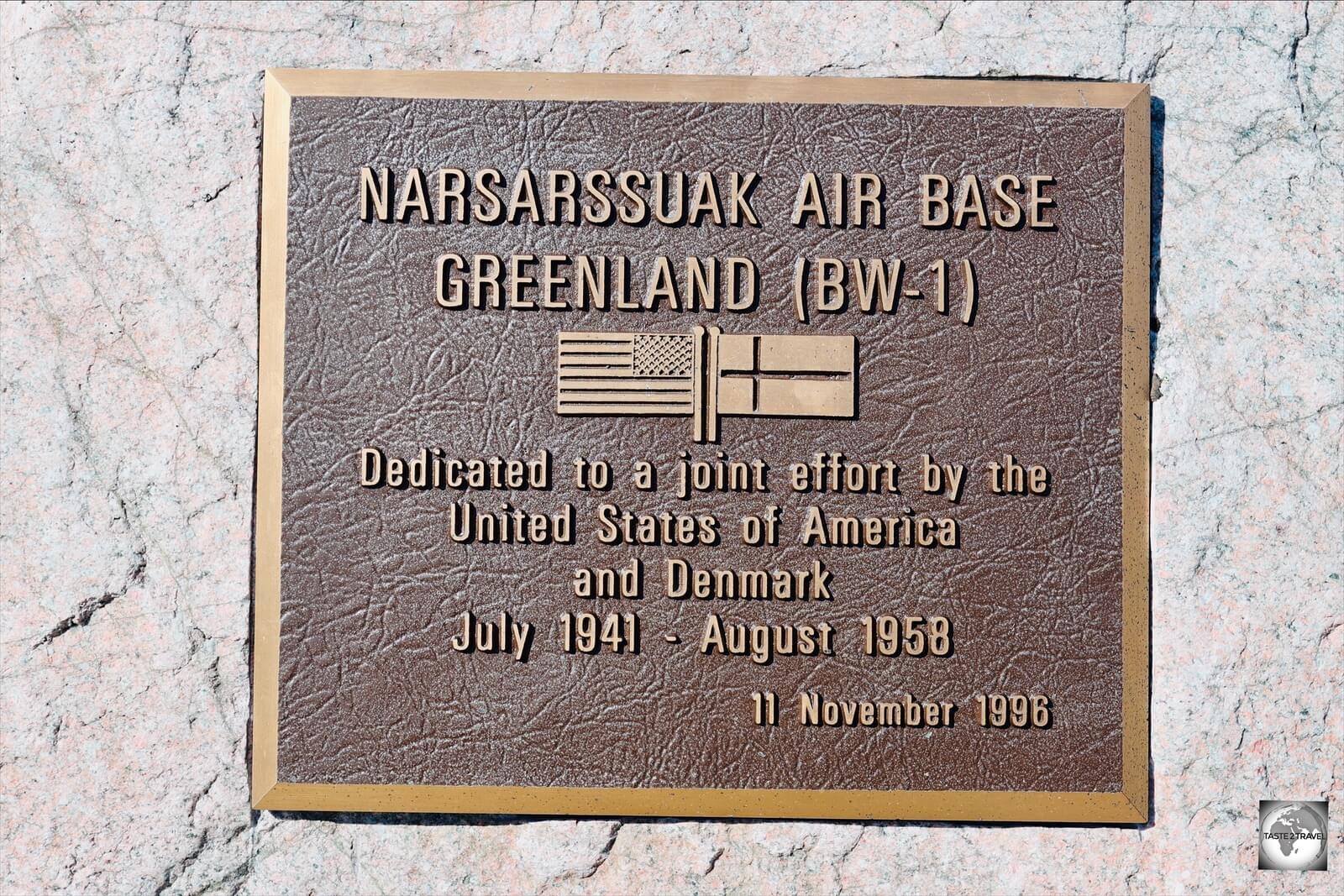
Memorial at the Narsarsuaq Museum.
The Americans arrived, via a ship convoy from New York City, and set about building an 1,830-metre (6,004 ft) airstrip.
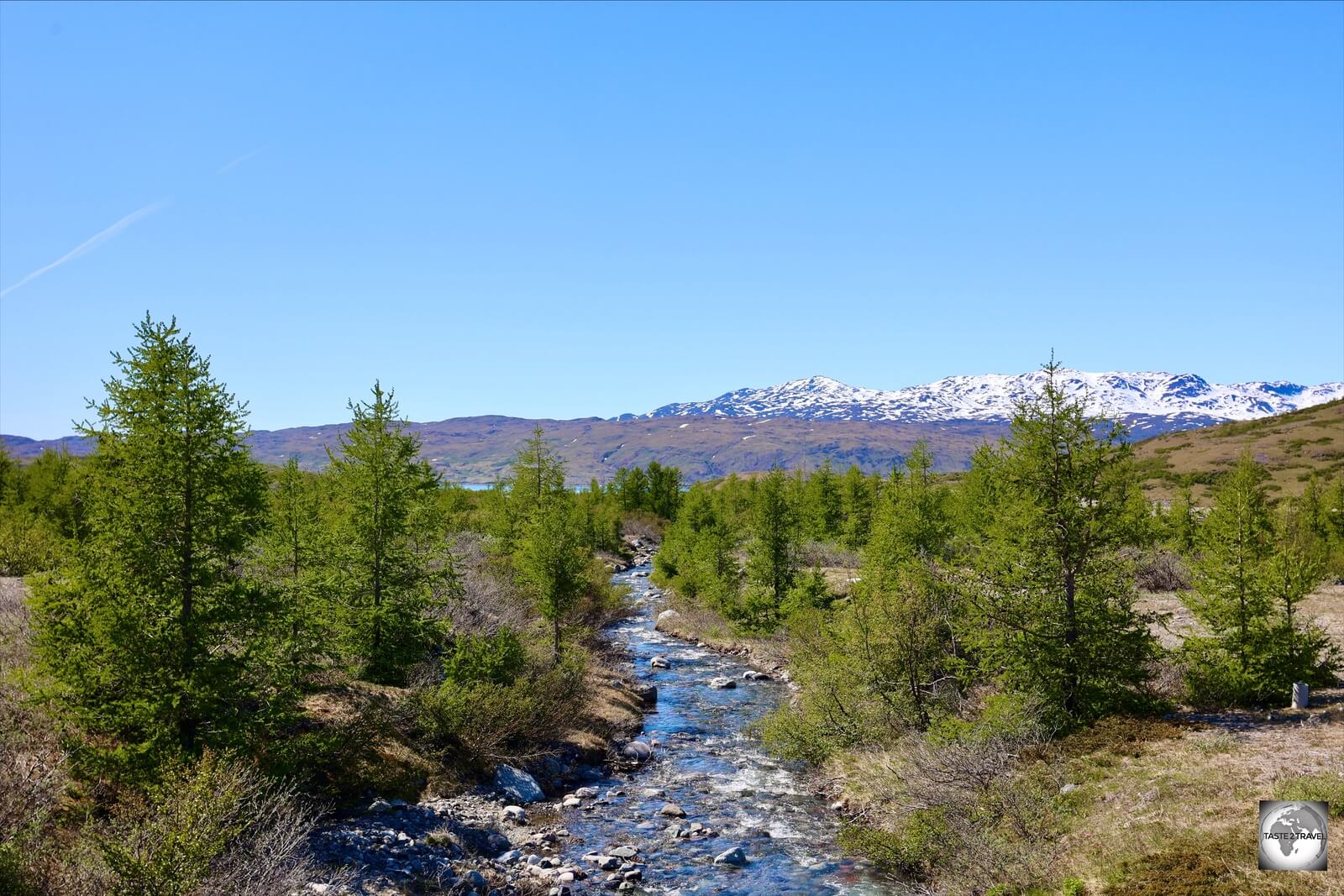
During their stay at Narsarsuaq, the Americans introduced trees to the area – the only trees to be found on Greenland.
Today, the old air base serves as Narsarsuaq International airport, offering one domestic flight per day to Nuuk and helicopter transfers to towns in southern Greenland.

A view of the glacial valley at Narsarsuaq.
The airport is the only reason for the existence of the tiny settlement, which is home to 120 souls, most of whom work at the airport.

Roads, which were built by the Americans during WWII, are still in use in Narsarsuaq.
All of this is scheduled to change once the new Qaqortoq International airport is opened in 2025.

Narsarsuaq offers many excellent hiking opportunities.
I have been told that Narsarsuaq airport will be moth-balled and the Narsarsuaq hotel will be closed.

A hay field, set inside the glacial valley at Narsarsuaq.
However, the area around Narsarsuaq offers much tourist potential, with many wonderful hiking opportunities, including up to the Greenland Ice Sheet.

A lone chimney in Narsarsuaq is all that remains from a former US Military hospital.
Getting There
Air
Narsarsuaq is currently one of 3 international airports on Greenland. During the summer season, there are very occasional flights connecting this sleepy outpost to Copenhagen and Reykjavik.
Air Greenland helicopter transfers from Qaqortoq, and other towns in the south, arrive at the airport and connect with the one domestic flight each day to Nuuk.
Sea
Disko Line offer fast speed boat transfers from Narsarsuaq to Narsak and Qaqortoq.

The settlement of Narsarsuaq lies at the end of the stunning Tunulliarfik Fjord.
Nuuk

A collage – “The Houses of Nuuk”.
Greenland National Museum

Ethnographic displays at the Greenland National Museum in Nuuk.
The oldest museum on Greenland, the Greenland National Museum features ethnographic displays, artefacts from archaeological digs and even some spectacular mummies!

Details of Inuit clothing at the Greenland National Museum.
Greenland Mummies
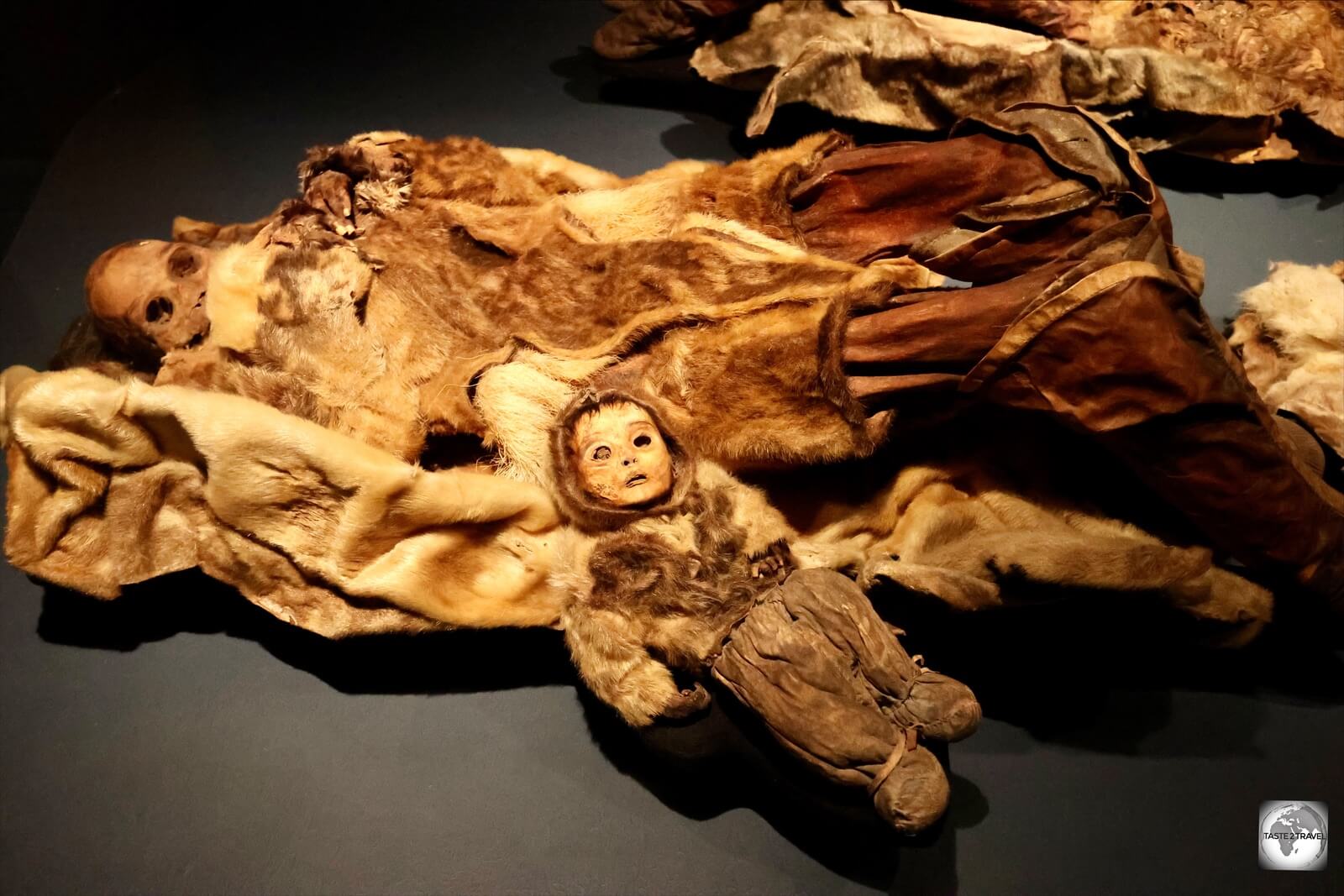
Found in a cave in 1972, these perfectly preserved mummies include a 6-month-old child.
A truly spectacular sight, hidden away in a back room of the Greenland National Museum, are a group of perfectly preserved mummies, still wearing their clothes and boots.

A 500-year-old mummy, fully dressed in boots, a coat and a hat.
This is one quirky attraction which I was not expecting to find on Greenland!
These 500-year-old mummies were found frozen under a pile of stones in a cave, near the northern town of Uummannaq, by two brothers in 1972.
The two grave chambers contained six adult women and two children, including a 6-month-old child.

The Uummannaq mummies are fully dressed, ready for their journey in their afterlife.
They are considered to be the best-preserved human remains ever discovered in North America, with the mummies fully dressed, including boots, ready for their journey in the afterlife.
A truly incredible sight!
Nuuk Local Museum
Located next door to the Greenland National Museum, the much smaller Nuuk Lokalmuseum features contemporary displays related to the people and history of Nuuk.

A statue in Nuuk provides the perfect resting place for a young Inuit girl.
Church of Our Saviour

Built in 1849, the Church of Our Saviour is a prominent landmark in Nuuk.
Established in 1849, Nuuk Cathedral or Church of Our Saviour is a cute, red, wooden Lutheran church which is located in the historic section of Nuuk.

The Danish flag flying in Nuuk.
Hans Egede Statue
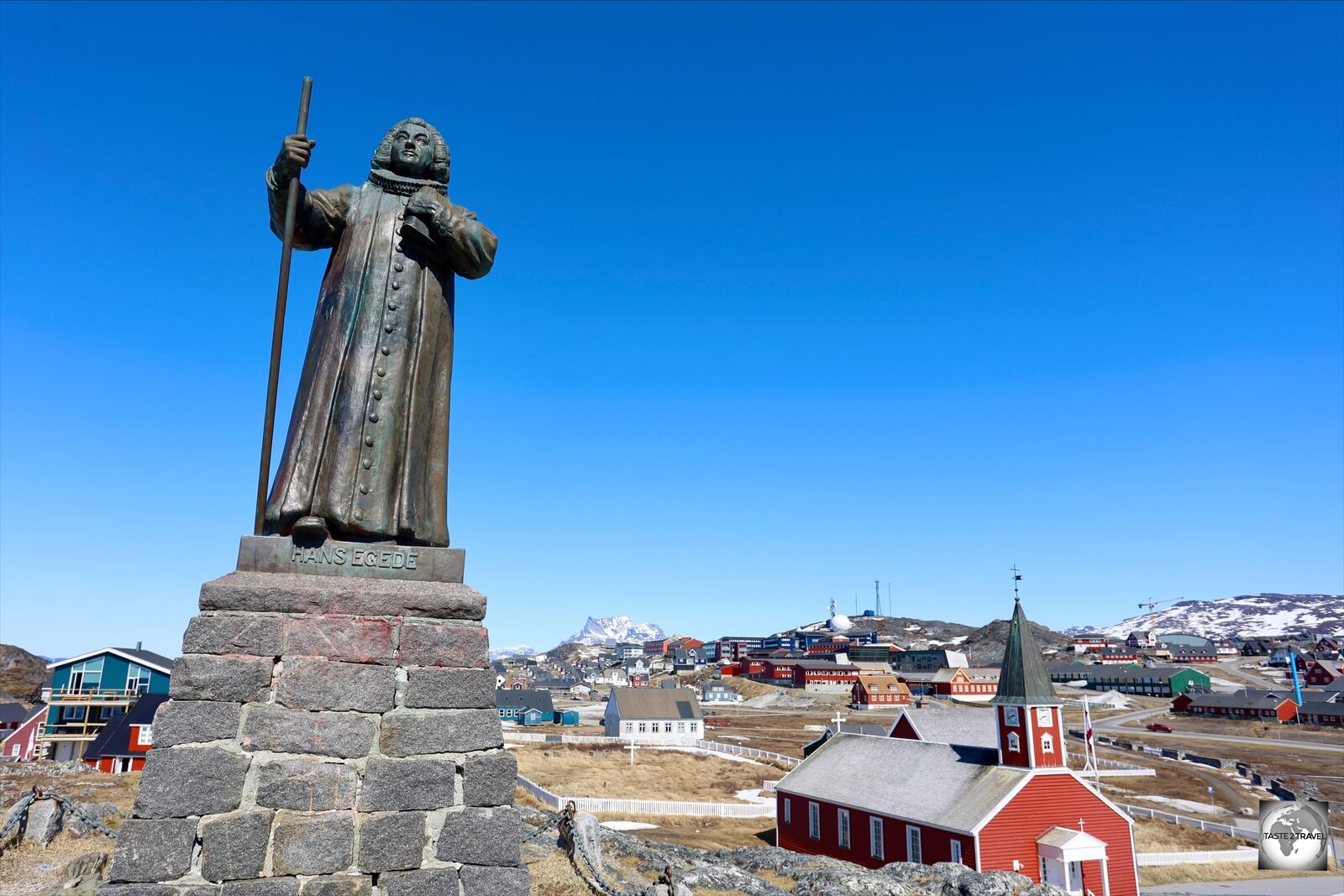
A statue of the Danish missionary, Hans Egede, who founded Nuuk in 1728.
Located on a hill, overlooking the Church of Our Saviour, the Statue of Hans Egede commemorates the Danish Lutheran missionary who founded Nuuk in 1728.
If you’re visiting Copenhagen, you’ll find a duplicate statue outside the Frederik’s Church (Marmorkirken).
Cemetery

A cemetery in downtown Nuuk.
There are a couple of cemeteries in downtown Nuuk, both of which are home to a forest of white crosses.
Getting There
Air
Nuuk is the main hub for Air Greenland who operate regular domestic flights to all parts of Greenland.
Each morning, the entire fleet of Air Greenland Dash-8 planes is lined up at Nuuk airport, ready to convey passengers to Kangerlussuaq Airport for the daily Airbus A330 flight to Copenhagen.
Sea
The Sarfaq Ittuk calls at Nuuk during its journey along the coast, spending 3-hours in port.

A view of the ‘beach’ in Nuuk, where the water is a refreshing 2 degrees!
Accommodation
There are surprisingly few hotels on Greenland. Most towns offer one accommodation option while Nuuk, Ilulissat and Sisimiut are the only towns to offer multiple options.
As can be expected from monopoly hotel operations in remote towns, they don’t have to try too hard and they never have to waste money on renovations or ensuring that they are keeping up with the competition!
The best towns for accommodation on Greenland are Ilulissat and Nuuk.
Ilulissat
As the main tourist centre on Greenland, Ilulissat has more hotel options than anywhere else! A full list of Ilulissat hotels can be found on the Visit Greenland website.
While there are many options in Ilulissat, I have highlighted four of my favourites here, including my accommodation choice – the Hotel Icefiord Apartments. These apartments offer the best value for long-term stays.
Hotel Icefiord

One of the best hotels in Ilulissat, the Hotel Icefiord overlooks the iceberg filled Disko Bay.
Occupying the best position of any hotel in Ilulissat, the Hotel Icefiord overlooks the iceberg-filled Disko Bay. If you are on foot, the hotel is about a 15-minute walk from town.

A view of Disko Bay from the balcony of the Hotel Icefiord in Ilulissat.
The hotel offers 36 rooms and 3 apartments which are located next to the hotel.
Apart from being a cosy hotel, offering a breath-taking view of Disko Bay, the Hotel Icefiord is home to a superb restaurant which offers the finest dining experience in Ilulissat (please refer to the ‘Eating Out‘ section for more details on this gem!)
Rates:
Rooms can be booked online, with current rates being:
- Deluxe Explorer room (for two) – DKK3,995 (€536)
Hotel Icefiord Apartments

My accommodation at the Hotel Icefiord Apartments in Ilulissat.
Also, by the Hotel Icefiord, the Hotel Icefiord Apartments offer the best value accommodation, especially if you are in town for more than a few days. I spent 6 days in one of their apartments and would happily return again!
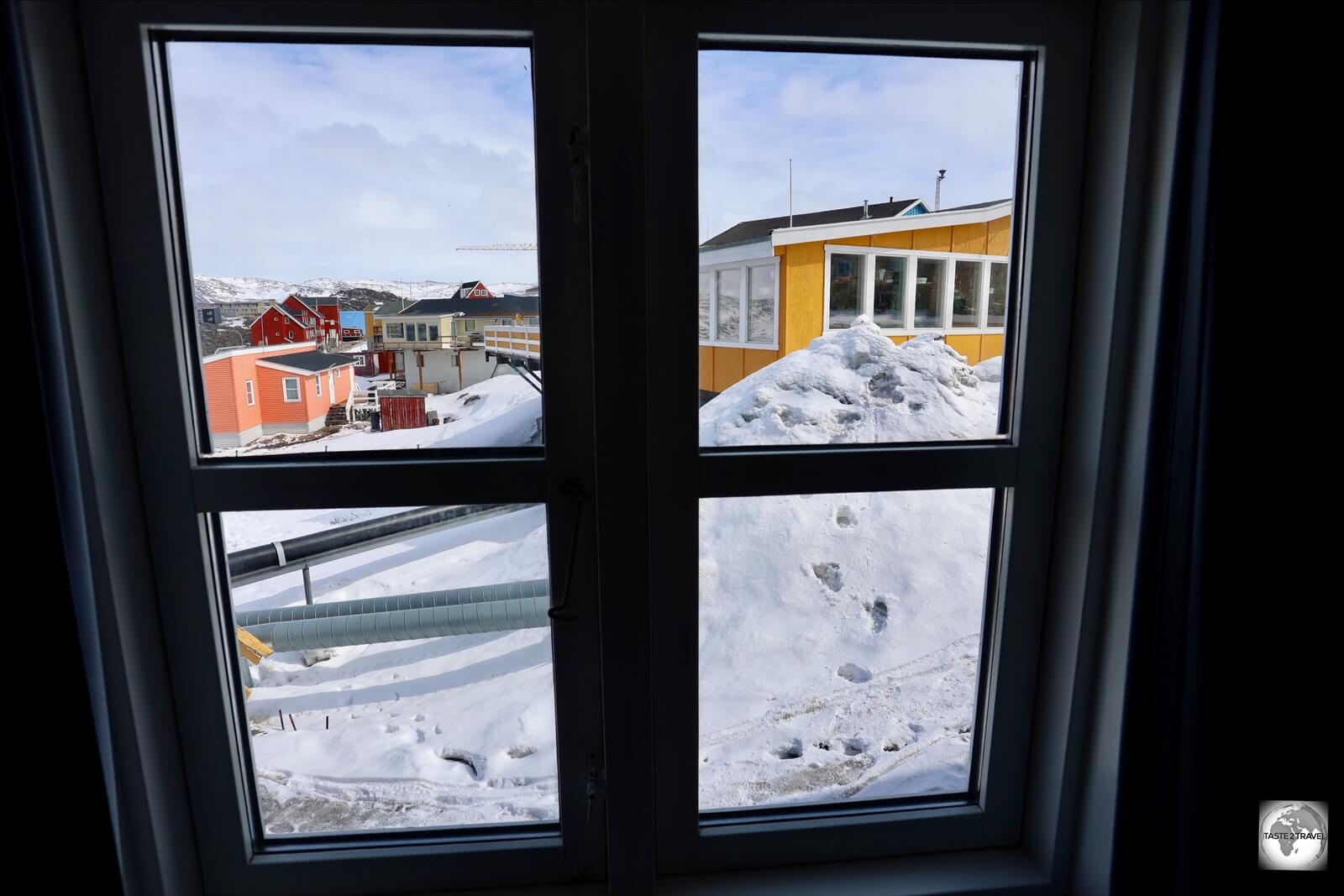
The chilly view from the window of my apartment at the Icefiord Apartments in Ilulissat.
The eight, 1-room, apartments are housed in a small wooden building in the centre of town, a short walk from most cafes, restaurants and the supermarket.
An added extra here is the communal laundry, which is highly appreciated by someone who is always on the road.
Rates:
Rooms can be booked online, with current rates being:
- Standard Apartment (1 person) – DKK1,260 (€170)
- Standard Apartment (2 persons) – DKK1,560 (€210)
Hotel Arctic

The Hotel Arctic bills itself as the world’s northernmost four-star hotel.
Located on the northern outskirts of town, on the way to the airport, the Hotel Arctic claims to be the world’s northernmost four-star hotel.
A regular (free) shuttle bus connects the hotel to town, although it is just a 15-minute walk and the views over Ilulissat are stunning in all directions.

The view over Disko Bay from the boardwalk at the Hotel Arctic, Ilulissat.
At the rear of the hotel, an elevated boardwalk provides stunning views over Disko Bay.
The hotel restaurant, Brasserie Ulo, offers divine cuisine and a sunny terrace overlooking Disko Bay.
Every Saturday, the terrace is the venue for a Greenlandic BBQ which costs DKK395 (€53) per person.
Rates:
Rooms can be booked online, with current rates being:
- Standard double room – DKK2,575 (€346)
- Superior room – DKK2,776 (€373)
- Premium double room – DKK2,969 (€399)
- Junior double room – DKK3,371 (€453)
Best Western Plus Hotel Ilulissat

The newest hotel in Ilulissat, and the only high rise in town, the ‘Best Western Plus Hotel Ilulissat’ offers the best views of Ilulissat from its rooftop restaurant.
Rising like a shiny beacon from the centre of Ilulissat, the Best Western Plus Hotel Ilulissat is the first high-rise building in Ilulissat, the first Best Western property in Greenland and the first hotel built in Greenland by a major international hotel chain.
The hotel offers a fancy lobby, beautiful, modern, crisp rooms and an unbeatable panoramic view over Ilulissat and Disko Bay from the rooftop restaurant.
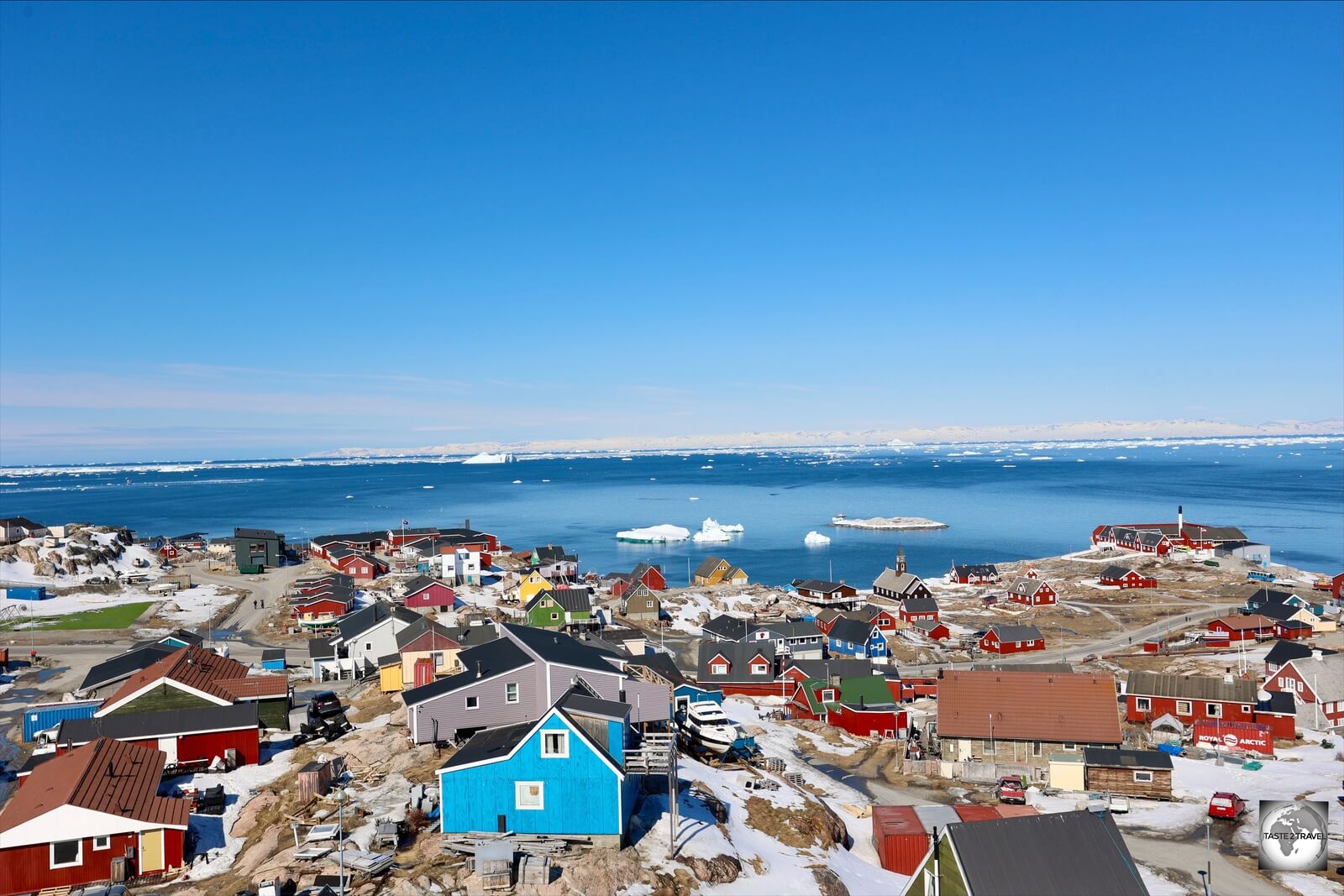
The main reason to visit the Best Western hotel – the spectacular view over Ilulissat and Disko Bay from the rooftop restaurant.
The hotel offers 78 modern rooms in 5 different room types – 30 standard rooms, 12 family rooms, 18 executive rooms, 16 superior rooms and 2 suites.
Rates:
Rooms can be booked online, with current rates being:
- Standard room – DKK2,560 (€344)
- Superior room – DKK2,746 (€369)
- Family room – DKK3,700 (€497)
- Executive/ Suite room – DKK4,265 (€573)
Nuuk

The Hotel Hans Egede in downtown Nuuk.
The capital of Greenland boasts more than a dozen hotel options.
The leading hotel in town is the centrally located Hotel Hans Egede, which also operates nearby apartments and the much newer (and my accommodation choice) – the Hotel HHE Express (HHE = Hotel Hans Egede).
Hotel HHE Express

Modern and very new! My room at the Hotel HHE Express in Nuuk.
While in Nuuk, I chose to stay at the newly opened Hotel HHE Express which is part of the Hotel Hans Egede family.
The rooms are well designed, apart from the fact that the beds are jammed up against the window, and a buffet breakfast is included in the nightly rate.

The 2-star Hotel HHE Express offers comfortable, modern rooms in the heart of Nuuk.
The hotel is located in the heart of Nuuk, a short walk from everything.
Highly Recommended!
Rates:
Rooms can be booked online, with current rates being:
- Express room – DKK1,085 (€146)
- Plus room – DKK1,260 (€169)
- Sea room – DKK1,355 (€182)
Qaqortoq
Hotel Qaqortoq

The excellent Hotel Qaqortoq, which is perched on a small hill, overlooking the tourist information centre and the port.
An exception to the rule of “monopoly hotels in remote towns not trying too hard” is the amazing Hotel Qaqortoq.
The only property in tiny Qaqortoq, the Hotel Qaqortoq offers beautiful, well-designed, comfortable rooms overlooking the port.
Everything here, from the service, food and facilities is excellent.

My room at the Hotel Qaqortoq, which included a seal-skin throw on the bed.
The Hotel Qaqortoq was my favourite hotel in Greenland! A very nice buffet breakfast is included in the nightly room rate, while the hotel restaurant, Café/ Brasserie Nanoq is one of the most popular meeting places for locals.
If you’re arriving on the Sarfaq Ittuk, the hotel is located directly in front of the port, a 2-minute (uphill) walk.
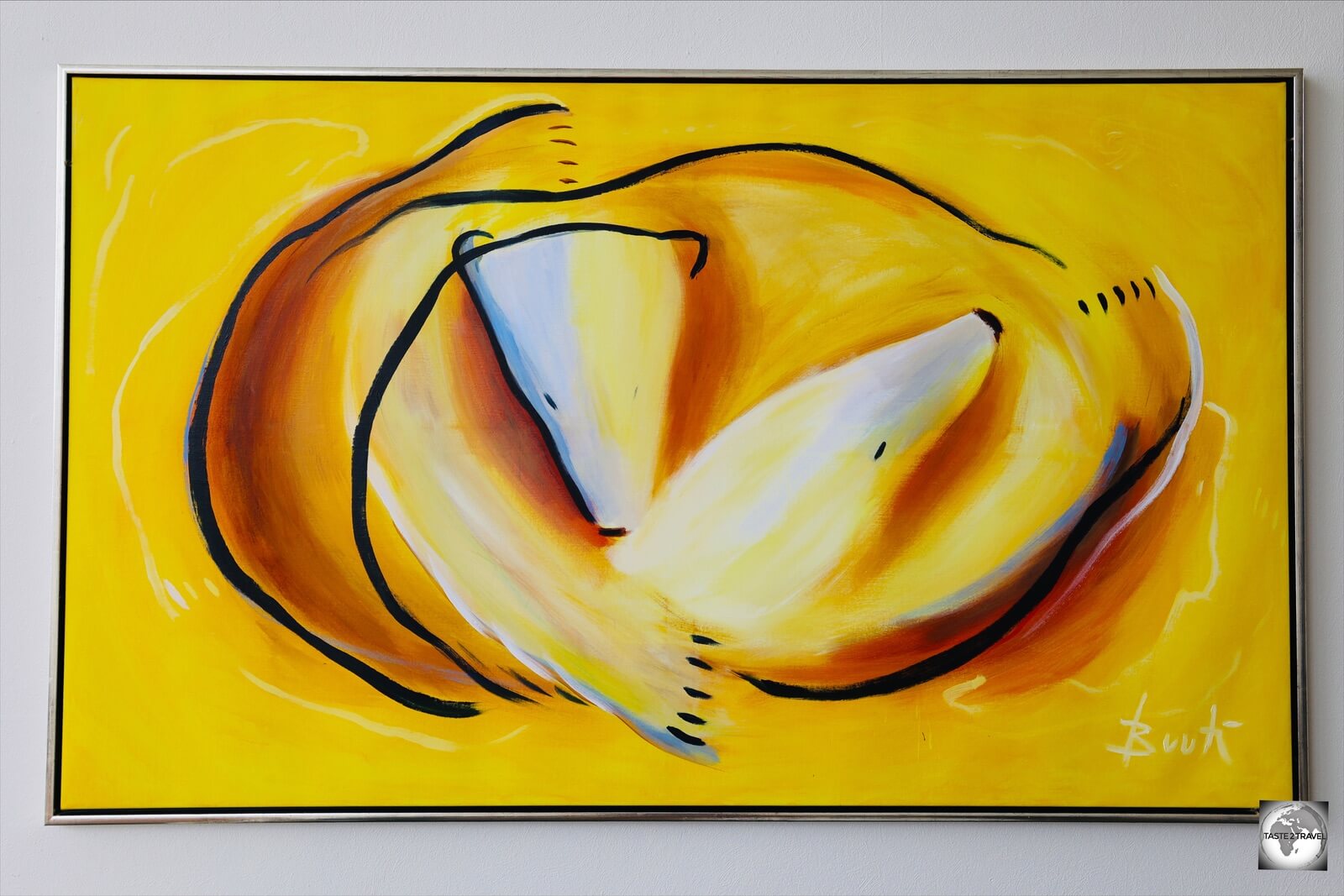
Polar bear artwork adorns the walls of the Hotel Qaqortoq.
What I especially loved about the Hotel Qaqortoq was that it is both a hotel and art gallery. The walls of the hotel are lined with iconic polar bear paintings from a local artist.
Such beautiful works of art!
Rates:
Rooms can be booked online, with current rates being:
- Single room – DKK1,495 (€200)
- Double/ Twin room – DKK1,895 (€255)

A polar bear skin and polar bear artwork adorn the walls of the Hotel Qaqortoq.
Narsarsuaq
Hotel Narsarsuaq

Old and dated – my room at the Hotel Narsarsuaq.
At the other end of the comfort and style spectrum – the very average Hotel Narsarsuaq is very much a monopoly hotel which doesn’t try to impress!
The hotel offers the only accommodation in tiny Narsarsuaq (pop: 120), with 92 old and tired rooms lining a long corridor in two annexes.

The reading room at the Hotel Narsarsuaq.
Located across the road from the airport, the hotel is operated by the airport company and is scheduled to be closed once Narsarsuaq airport is closed (scheduled for 2025 – but subject to delays).
Hotel Narsarsuaq has an institutional feel to it and reminded me of sad and forlorn hotels in the former Soviet Union.
The upstairs restaurant is one of two places to eat in Narsarsuaq (see the ‘Eating Out‘ section below for more details) and serves as the cafeteria for the airport workers.
Rates:
Rooms can be booked online, with current (summer) rates being:
- Single room – DKK1,415 (€190)
Eating Out
What’s the most popular restaurant food among the local Inuit? Hamburgers, French fries, nachos and chicken nuggets!
Restaurants and cafes on Greenland serve standard international staples. If you wish to sample local produce, such as reindeer or freshly caught halibut fish, you’ll find these on the menu in some of the more expensive, fine dining restaurants.
The cost of eating out is affordable, with most cafes and restaurants full of locals at lunchtime (the most important meal of the day). The cost of a sandwich or hamburger, with drink, is around DKK150 (€20).
Restaurants/ Cafés
Ilulissat
Icefiord Hotel Restaurant

The view over Disko Bay from the restaurant at the Icefiord Hotel in Ilulissat.
Ilulissat is blessed with many dining options, including the Icefiord Hotel Restaurant which serves the most amazing gourmet food.
The informal dining room overlooks the totally surreal Disko Bay, which is normally full of floating icebergs.
Main courses include local reindeer, freshly caught redfish, musk ox and even a Halibut ceviche! Everything is presented perfectly and the servers will explain every aspect of your dish.
This is a compulsory dining experience for visiting gourmets!

A truly divine meal – reindeer fillets in a red-wine reduction with berries and beetroot prepared 3 different ways!
For my main course, I enjoyed the local reindeer fillets which included beetroot served 3 different ways – including smoked beetroot which is smoked onsite in their smokehouse. An amazing explosion of flavours!
The desserts are equally divine! I finished my meal with their apple sorbet, which was served with apples cooked three different ways, roasted meringue, salted caramel and crispy oats.
Eating at the Icefiord Hotel restaurant is a splurge – but totally worth it!
Best Western Ilulissat Hotel Restaurant

A view of Ilulissat and Disko Bay from the rooftop restaurant at the Best Western Hotel Ilulissat.
While the views of Disko Bay from the Icefiord Hotel restaurant are unbeatable, the panoramic views from the rooftop of the newly opened Best Western Hotel Ilulissat are also impressive!
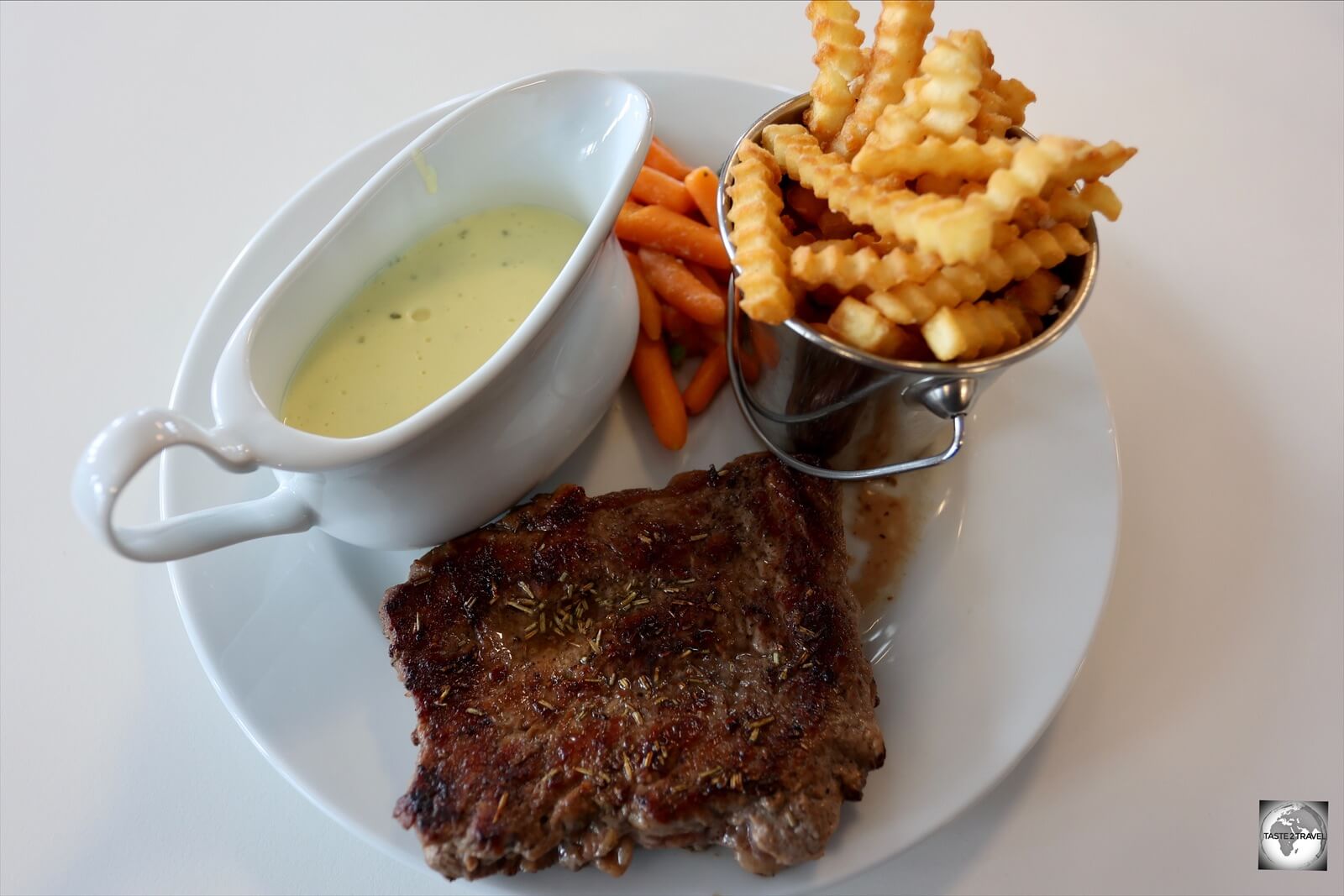
My delicious steak dinner at the Best Western Hotel Ilulissat restaurant.
The menu includes a 225g steak (DKK238 / €32) served with French fries and a sauce of your choice.
A .45L glass of beer costs DKK75 (€10).

The Cafennguaq in Ilulissat is a popular lunchtime cafe for locals.
A popular lunchtime choice for locals in Ilulissat, the busy Cafennguaq serves tasty sandwiches along with the regular favourites (hamburgers, nachos, chicken nuggets etc).
If you wish to get a seat, its best to arrive before the 12 pm rush-hour.
Qaqortoq
There are just a couple of worthwhile restaurants and cafes in tiny Qaqortoq.
Kunguak Cafe & Icebar
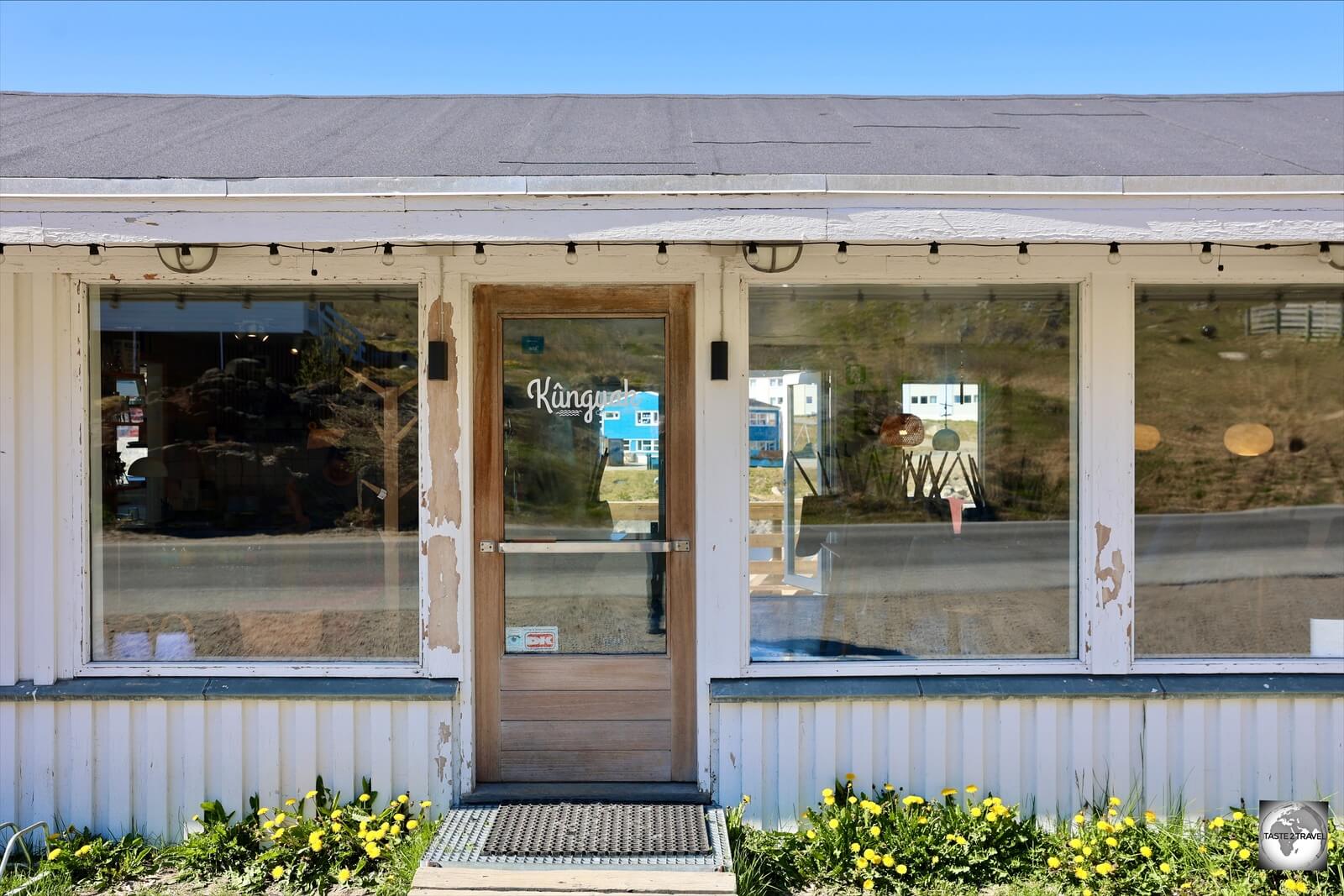
Located out towards the lake, the tiny Kunguak Cafe and Ice bar serves the best coffee in Qaqortoq.
Located on the road which leads out of town, towards the lake, the Kunguak Cafe & Icebar is the one place in town where you can enjoy a proper Barista-made coffee.
If you do have a caffeine craving, you’ll need to wait until opening time which is 11 am.
All cafes on Greenland open at 11 am for lunch. There is no breakfast culture on Greenland.

The simple interior design of the Kunguak Cafe & Icebar in Qaqortoq.
Apart from serving fine coffee and homemade ice cream, the walls of the cafe serve as an art gallery, displaying artworks by local artists.
Café Nanoq

Part of Hotel Qaqortoq, the front door of the busy Café Nanoq is always open!
The best restaurant in Qaqortoq is Café/ Brasserie Nanoq which is part of the Hotel Qaqortoq.
The restaurant menu includes all the regular favourites such as burgers, pasta, sandwiches and salads.
This is the one other place in town offering Barista-made coffee.
The restaurant is home to the one bar in Qaqortoq – the Qapuk Bar, where you can sample the craft beers from the Qajaq Brewery, which is located in nearby Narsak.
Narsarsuaq
Hotel Narsarsuaq Restaurant

Very tasty! Crumbed Atlantic redfish with French fries and salad at the Hotel Narsarsuaq restaurant.
Although the very-average rooms at the Hotel Narsarsuaq are unremarkable, the meals in the upstairs restaurant are anything but!
There are just two places to eat in Narsarsuaq – the hotel restaurant and the nearby Café Polar-tut, although the hotel restaurant is the only dinnertime option.
Meals include freshly caught Atlantic redfish which is served crumbed with pickled ginger, French fries and salad. Very Nice! Especially when washed down with a craft beer from the folks at the nearby Qajaq Brewery.
Café Polar-tut

Although non-descript from the outside, the Café Polar-tut offers very good meals, coffee and amazing carrot cake!
Of the two dining options in Narsarsuaq, this is my favourite!
I spent two days in town and I ate here most of the time. Café Polar-tut is a slice of culinary heaven in an otherwise gourmet desert!

A café latte and a slice of homemade carrot cake at the Cafe Polar-tut in Narsarsuaq.
The owner, a very friendly and enthusiastic chef/ barista, serves tasty food (the burgers are very popular with the locals) and will offer you a generous slice of her homemade carrot cake to go with your coffee!

The interior of the Cafe Polar-tut in Narsarsuaq.
If you’re feeling thirsty after a hike in the surrounding countryside, a selection of craft beers from the Qajaq Brewery are available on tap. A craft beer and a homemade burger are the perfect lunch!
Nuuk
Kaffivik

Of all the cafes in Greenland, the homey and cosy “Kaffivik” gets my vote as the #1 cafe.
Hidden away in an obscure corner of an industrial estate in Nuuk, the cosy Kaffivik is THE best cafe on Greenland.
With its many sofas and coffee tables, and its coffee roasting room, this cafe/ roasting house sets a high standard for both coffee quality and a cafe experience.

A hidden gem – Kaffivik is located in a blue shed at the end of a road which leads through an industrial estate.
The whole operation is run by a friendly and energetic family who will satisfy any caffeine craving!
Highly recommended!

Danish-speaking, Filipino staff, ensure both Cafe Esmeralda and Pascucci operate efficiently.
The two busiest cafes in Nuuk – Pascucci and Café Esmeralda are run by the same company.

Café Esmeralda offers the best Sunday brunch in Nuuk.
One thing that differentiates Café Esmeralda from the competition is their excellent Sunday brunch buffet – the best brunch in Nuuk.
Bars

The best local beer on Greenland is brewed by the Qajaq (Kayak) Brewery which is located in the southern town of Narsaq.
There are surprisingly few bars on Greenland, with alcohol being served in cafes and restaurants as an accompaniment to meals.
While most beer in Greenland is imported from Europe, the Qajaq Brewery, (Qajaq = Kayak) located in the southern town of Narsak, is brewing a range of unique, local, craft beers.

Enjoying a glass of the ‘Christmas special’ craft beer from the Qajaq Brewery.
The water which is used in the brewing process is obtained from icebergs which are floating in the fjord, outside the brewery. This water is more than 4,000 years old.
Visa Requirements
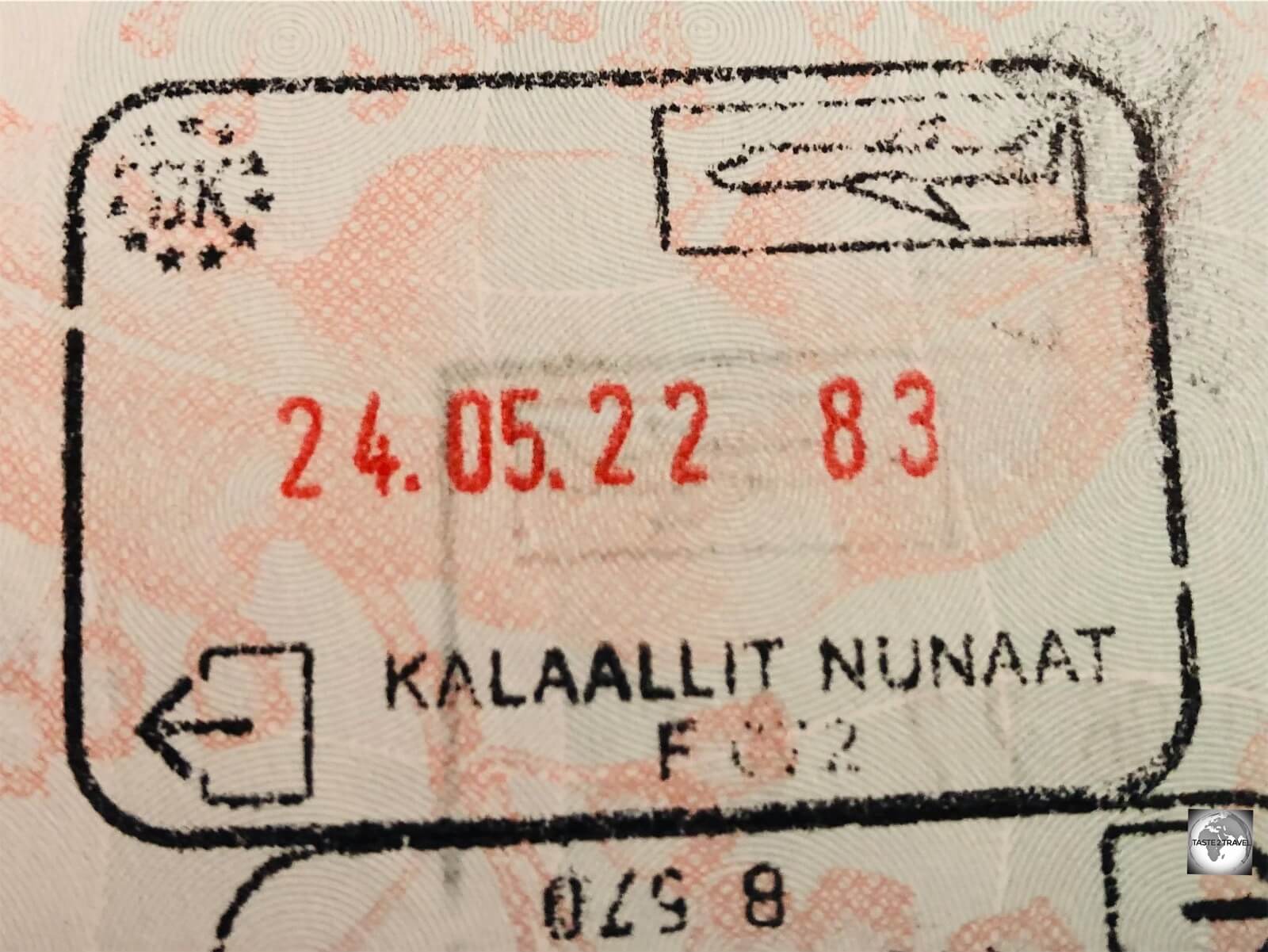
My Greenland passport stamp.
Being an autonomous country of the Kingdom of Denmark, Greenland maintains its own visa policy.
Nationals of the Nordic countries are free to enter, reside and work in Greenland, while nationals of other countries exempt from visas for short stays in the Schengen Area may also visit Greenland without a visa.
As an Australian passport holder, my passport was stamped upon entry into Greenland, although there were no controls in Denmark.
Many nationalities do require visas to enter Greenland. These can be obtained from Danish diplomatic missions.
To check your requirements, you should refer to the Greenland visa policy.
Getting There
There is only one way of reaching Greenland – by air! Arriving by sea is possible via cruise ship.
Air

Fresh off my flight from Copenhagen, and greeted by summer snow at Kangerlussuaq Airport.
There are three international airports on Greenland:
- The main gateway, Kangerlussuaq Airport, which offers one daily international service to Copenhagen airport.
- Nuuk Airport which offers international service to Keflavik airport in Reykjavík (Iceland).
- The very sleepy Narsarsuaq Airport which is located in southern Greenland and receives very occasional seasonal flights from Copenhagen and Reykjavík.
Both Kangerlussuaq and Narsarsuaq Airport were built in 1941 by the United States military as WWII air bases. Both are in remote, inconvenient locations but, most importantly, they feature long runways, which allow larger jets to land.
All of this will change in the coming years as three new international airports come online, allowing larger jets to arrive directly at Nuuk, Ilulissat and Qaqortoq. This will result in the current international airports, the former air bases, being decommissioned.
Kangerlussuaq Airport
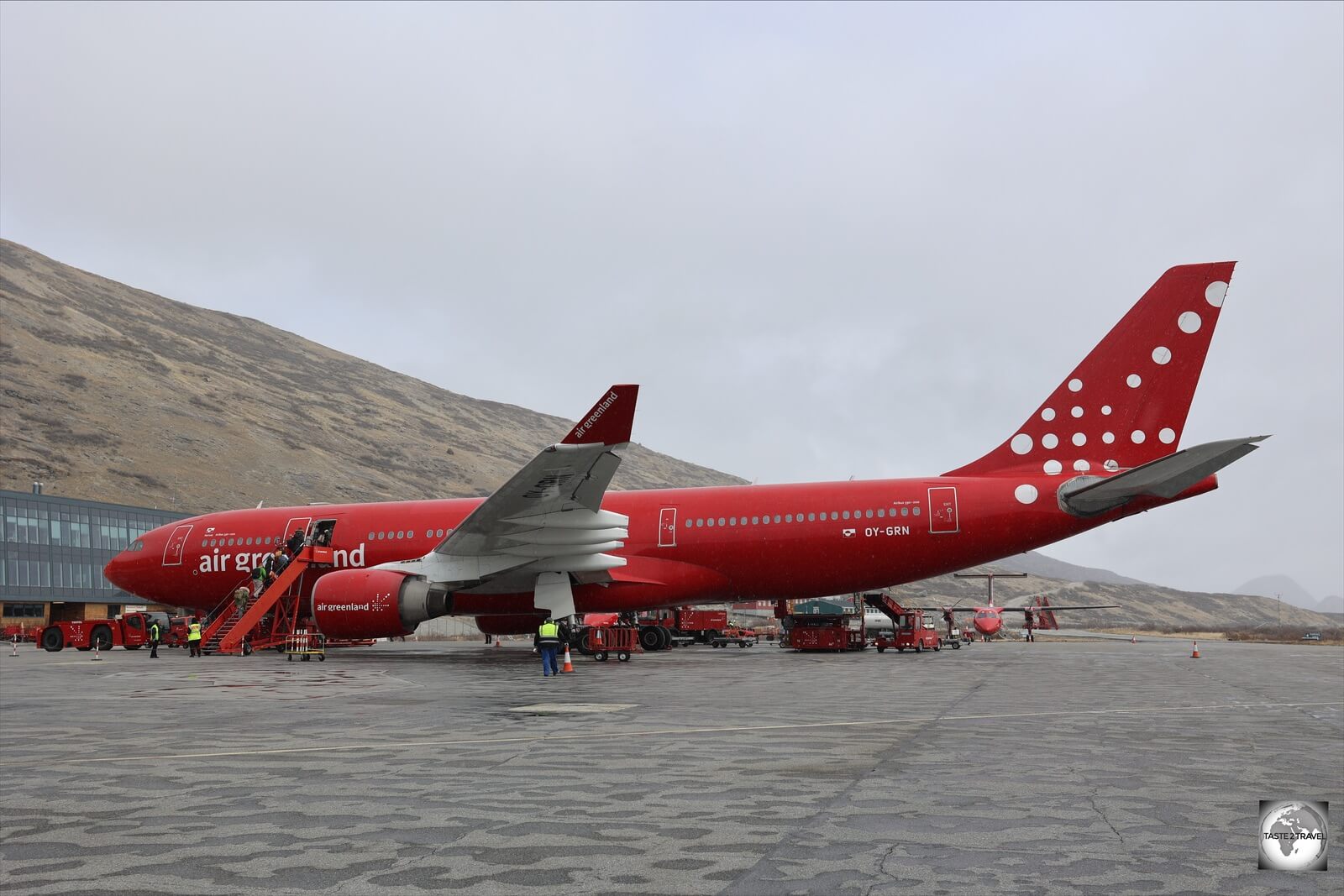
Air Greenland operate one Airbus A330, seen here at Kangerlussuaq Airport, which provides daily connections between Denmark and Greenland.
International flights to Greenland are operated by Air Greenland who have one Airbus A330 in their fleet. This workhorse provides a daily service between Copenhagen airport and Kangerlussuaq Airport.

The tiny terminal at Kangerlussuaq Airport, the main international gateway to Greenland.
The arrival gateway for almost all visitors to Greenland, the underwhelming Kangerlussuaq Airport features a hotel, giftshop and one cafe. A community of 500 souls keeps this remote facility operating. The airport is located 129 km inland from the coastal town of Sisimiut.
There are a couple of tourism operators who provide excursions in the local area. They can be found at a booth inside the terminal.

Boarding an Air Greenland Dash 8-200 plane at Kangerlussuaq Airport.
Almost everyone who arrives at Kangerlussuaq Airport transfers onto waiting Air Greenland Dash 8-200 planes which ferry international arrivals onwards to Nuuk, Ilulissat, Sisimiut and other domestic destinations.
Air Greenland operate a fleet of seven Dash 8-200 planes, whose main purpose is to ferry international passengers to/ from Kangerlussuaq Airport.
Each morning, an airlift operation is conducted by Air Greenland, who use their entire domestic fleet, to transfer passengers from Nuuk, and other destinations, to Kangerlussuaq Airport, in time for the daily departure of the Airbus flight to Copenhagen.
While the Air Greenland Airbus A330 has a capacity of 278 passengers, the Dash 8 planes have a capacity of just 40 passengers!
These same planes are then used to ferry the newly arrived passengers to their final domestic destinations.
Currently, the cost of flying to Greenland is made more expensive due to the fact that a transfer to a domestic flight is required at Kangerlussuaq airport.

A distance sign at Kangerlussuaq Airport.
Immigration Procedure
Immigration procedures are conducted at Kangerlussuaq Airport, with any non-EU passport holders having their passports stamped by Greenland immigration.
Narsarsuaq Airport

The terminal at the very sleepy Narsarsuaq Airport.
During the summer season, occasional international flights arrive at Narsarsuaq Airport. The airport mainly serves as a domestic hub for southern Greenland.
Icelandair provides the occasional connection to Keflavik (Reykjavik) airport, while Air Greenland provides, very occasional, services to/from Copenhagen airport.
I have been told by Air Greenland staff, that once the new Qaqortoq International Airport is opened in 2025, Narsarsuaq Airport will be closed.

The interior of Narsarsuaq Airport.
Air Greenland Route Map

Air Greenland Route Map.
International Services
- From Kangerlussuaq Airport, Air Greenland provides a daily service to Copenhagen using its one long-haul jet.
- From Nuuk, international flights operate to Reykjavík–Keflavík (Iceland).
- From Narsarsuaq Airport, very random, seasonal flights operate to Copenhagen and Keflavik.
Domestic Services
Daily domestic connections are provided to Aasiaat, Ilulissat, Maniitsoq, Narsarsuaq, Nuuk and Sisimiut.
A fleet of helicopters provides services to smaller settlements.
Airfares
As a monopoly operator, Air Greenland are free to charge what they want for flight tickets. You can check fares and book flights online.
A typical roundtrip international airfare from Copenhagen to Ilulissat costs around DKK10,000 (€1,340) during the summer season.
Domestic airfares are very expensive, with a one-way flight from Narsarsuaq to Nuuk (1:15 hrs) costing me DKK3,000 (€400).
Airport Development Program
The Greenlandic Government has an ambitious plan to build three new international airports in Greenland by 2025: Nuuk, Ilulissat and Qaqortoq.

Moving mountains – a view of the huge earthworks program which supports the extended runway at Nuuk airport.
In order to extend existing runways, contractors are literally moving mountains and filling up part of the sea.
Capacity Issues
While it’s great that three new international airports will come online in the next few years, there are two critical capacity issues affecting tourism in Greenland:
- A lack of aircraft operated by Air Greenland.
- A lack of hotel rooms.
Aircraft
Air Greenland currently operate one long-haul jet which is used on their daily flight between Greenland and Denmark.
If more international services are to be introduced, more planes will be required.
On the domestic front, Air Greenland rely on their fleet of seven (ageing) Dash 8-200 planes which have a passenger capacity of just 40!
Recommendations have been made by specialist consultants that the airline replace their current Dash 8 fleet in favour of much larger ATR-72 planes which have a passenger capacity of 72, thereby almost doubling their current carrying capacity. The airline has not acted on this recommendation.
All of this means that the new airports will be under-utilised unless the current fleet is significantly expanded.
Hotels
On the hotel front, most towns have just one hotel. The only towns which offer more than one hotel are Nuuk, Ilulissat and Sisimiut (2 hotels).
During my stay in Ilulissat, the small number of hotels were booked out for most of the summer season.
There are no new hotels being built at the moment which will restrict the number of visitors who can holiday in Greenland.
The new international airports include:
Nuuk

The terminal a Nuuk airport, which is in the process of being converted into an international airport.
A new 2,200 metre runway is being constructed at Nuuk airport, which will allow it to operate as an international airport. The airport is currently operating with a 950-metre-long runway which does not allow large jets to land.
The project consists of a runway, two taxiways, a control tower and a terminal area with an apron. Construction began in January 2020 and, following delays due to Covid-19, is expected to be completed by 2024.
Ilulissat

The terminal at Ilulissat airport, which is in the process of being converted into an international airport.
A new 2,200 metre runway is being constructed at Ilulissat airport, which will allow the domestic airport to operate as an international airport. Construction began in January 2020 and is expected to be completed by 2024.
Qaqortoq
A completely new build, Qaqortoq International Airport will feature a shorter runway at 1,500 metres but will be positioned so that it can be extended up to 1,799 metres.
It is planned that the airport will receive aircraft with 70 – 100 passengers from nearby destinations such as Iceland and Iqaluit (capital of Nunavut, Canada).
Once Qaqortoq International Airport is commissioned (planned for 2025), Narsarsuaq Airport (the current gateway to southern Greenland) will be closed!
Getting Around

A view of the Greenland coast, from the deck of the Sarfaq Ittuk passenger ship.
Greenland is unique in that there are no roads between towns, only within them and around them. There are 150 km (90 mi) of roads on the whole island, with just 60 km (40 mi) of paved surfaces!

There are just three sets of traffic lights on Greenland – all are located alongside each other, on the main street of Nuuk.
It’s always interesting to see luxury German cars in Greenlandic towns, knowing that they can never be driven on an open highway!
The only way to move around Greenland is by air or sea!
Air

An Air Greenland flight arriving at Ilulissat.
Air Greenland are the monopoly operator in Greenland. As can be expected, domestic airfares are horrendously expensive and are beyond the reach of most ordinary Greenlanders who instead chose to travel between towns on the Sarfaq Ittuk.

A view of a glacier and the Greenland Ice Sheet from an Air Greenland flight.
Despite the high price, most flights offer panoramic views of the stunning glaciers and ice sheet. They are the ultimate joy flights!

Air Greenland have seven helicopters in their domestic fleet.
Air Greenland operates a fleet of 7 Dash 8-200 planes and 7 helicopters. Due to the difficult terrain, where runway construction is impossible, many towns have a helipad instead of an airport.

An Air Greenland Dash 8-200 plane at Narsarsuaq Airport.
Sea

The Sarfaq Ittuk, seen here in Qaqortoq port, provides an essential service to 11 remote settlements along the southwest coast of Greenland.
With the cost of domestic flights being on the exorbitant side, the best value travel experience is offered by the one passenger ship – Sarfaq Ittuk – which offers a regular shuttle service along the southwest coast, connecting 11 settlements.
The Sarfaq Ittuk offers the most exciting sightseeing opportunity in Greenland – and an unforgettable travel memory.
For full details, please refer to the ‘Sightseeing’ section.
Nuuk Water Taxi

The Nuuk Water Taxi company provides daily sightseeing excursions on the nearby fjords.
In Nuuk, the Nuuk Water Taxi company provides tours and transport services on the nearby Fjords.
The company offers many different excursions which can be booked on their website. One of their more popular trips is a 3-hour Puffin bird watching safari which costs DKK900 (€120).
Disko Line

A Disko Line speedboat departing Qaqortoq for Narsaq.
The Disko Line company offer speedboat shuttle services between towns in northern, central and southern Greenland and also offer a range of exciting sightseeing excursions (please refer to the ‘Ilulissat Sightseeing‘ section for more details).

The view from my Disko Line speedboat, travelling between Qaqortoq and Narsarsuaq.
I travelled from Qaqortoq to Narsarsuaq on one of their scheduled speedboat departures, which cost me DKK890 (€120) for the 1:45 ride.

Views of the Tunulliarfik Fjord from my Disko Line speedboat.
I was the only passenger on the boat, and was free to stand out the back and take photos of the stunning scenery as we rocketed along the spectacular fjords at full speed.
It was a thrilling ride!
Land
Bus

There is just one bus operating a shuttle service between the pier and the airport in the settlement of Narsarsuaq.
Bus services operate in the main towns, including Nuuk, Sisimiut, Ilulissat and even in sleepy Narsarsuaq where one bus – route #01 – provides a free shuttle service between the dock and the airport.

A public bus in Ilulissat.
Taxi
Metered taxis provide services in the major towns, with a taxi from Nuuk airport to downtown Nuuk costing approximately DKK120 (€16) for the 10-minute trip.
Rental Car

Car license plates in Greenland follow the Danish design but are prefixed with either ‘GL’ or ‘GR’.
In a country with no road network, outside of the few towns, there really is no demand for rental cars.
If you need a car while in the capital, there is one car rental agent, Nuuk Biludlejning, which offers cars starting at DKK400 (€54) per day.
That’s the end of my travel guide for Greenland.
If you wish to provide feedback to me, you can do so by leaving a comment below.
Safe Travels!
Darren
Further Reading
Other travel reports from the Nordic region:
Follow me on Instagram
[Instagram-feed]
[maxbutton id=”1″]
Author: Darren McLean
Darren McLean is an Australian, full-time, digital nomad who has spent 37 years on a slow meander around the globe, visiting all seven continents, 192/ 193 UN countries and 245/ 251 UN+ countries and territories.
He founded taste2travel to pique one’s curiosity and inspire wanderlust.




Super website! Congratulations!
The question: Does it have a reason that you didn’t visit East Greenland (Kulusuk)?
Hi Emil,
It was a question of time. I would love to visit East Greenland. Maybe on my next visit.
Safe travels!
Darren